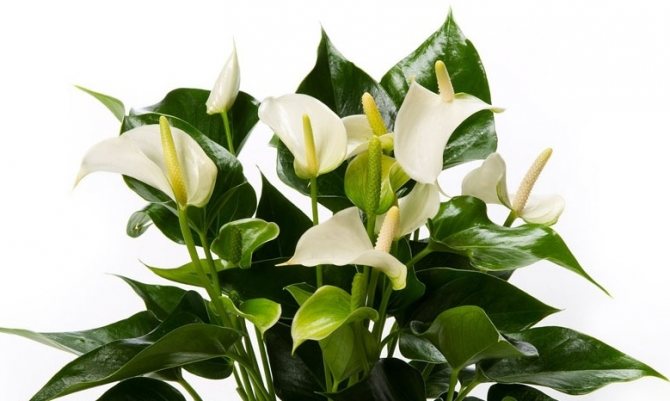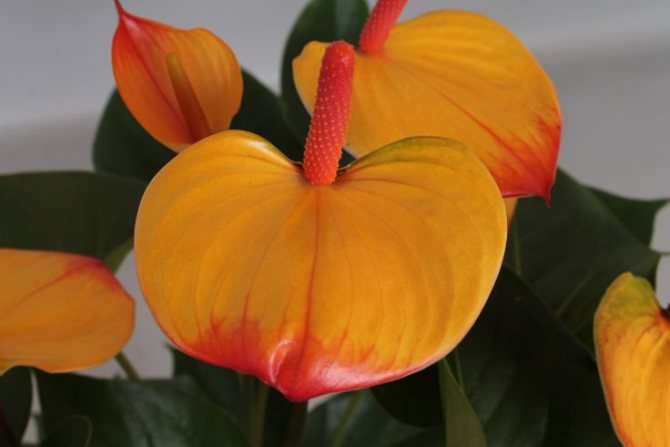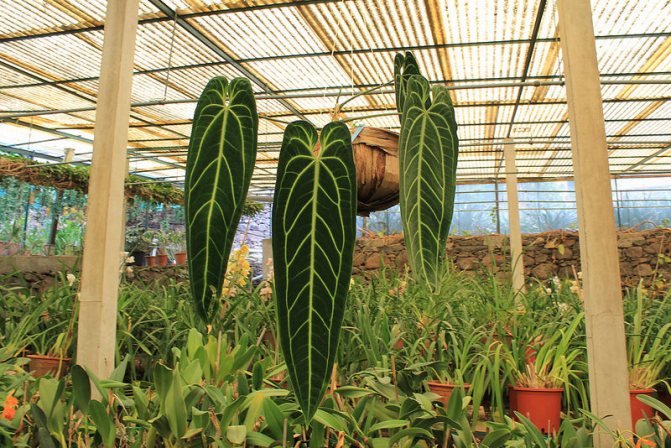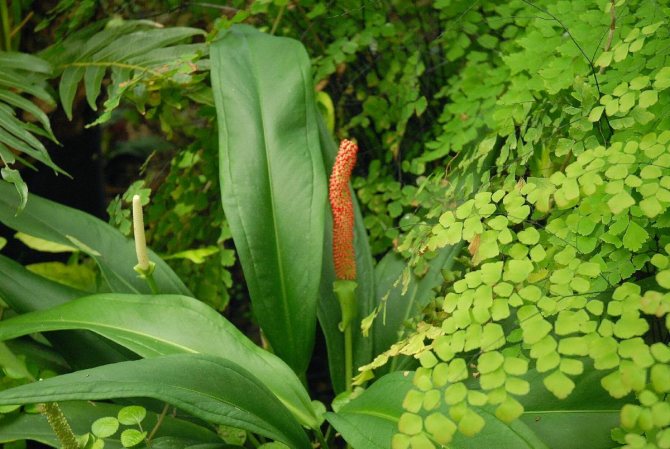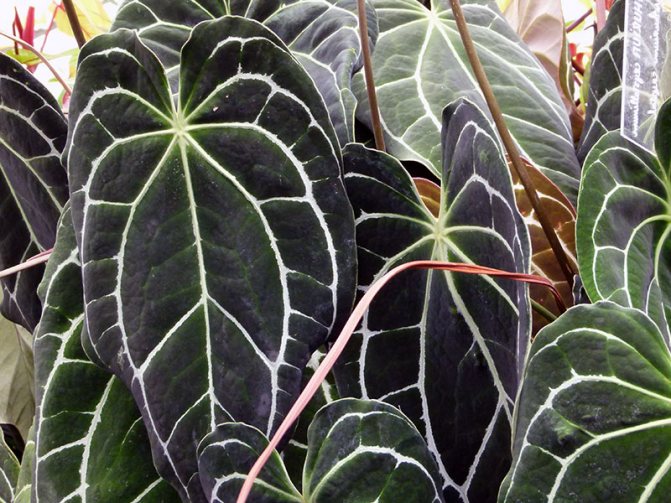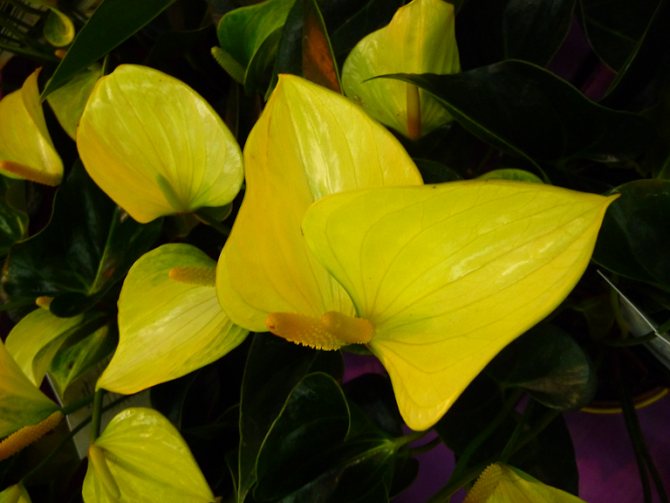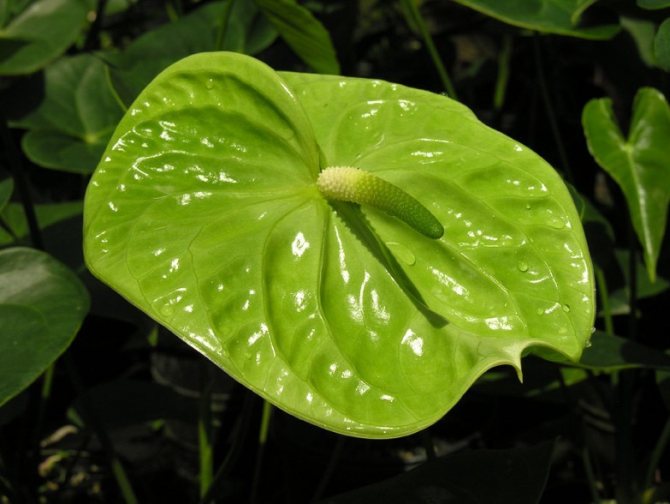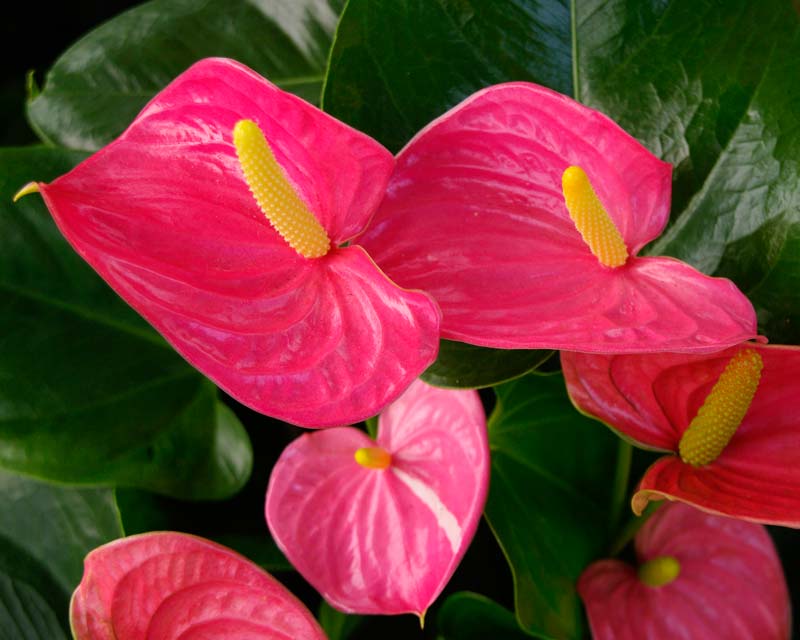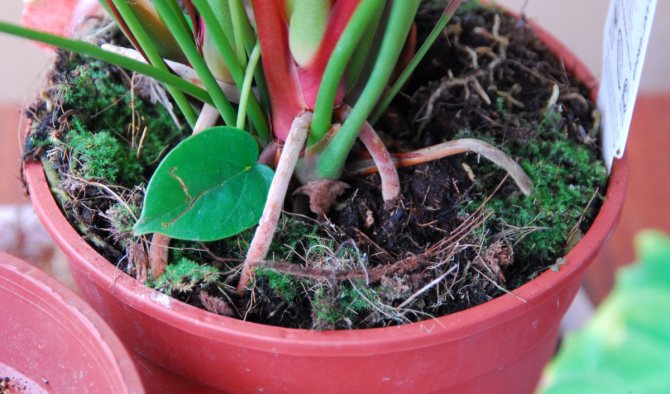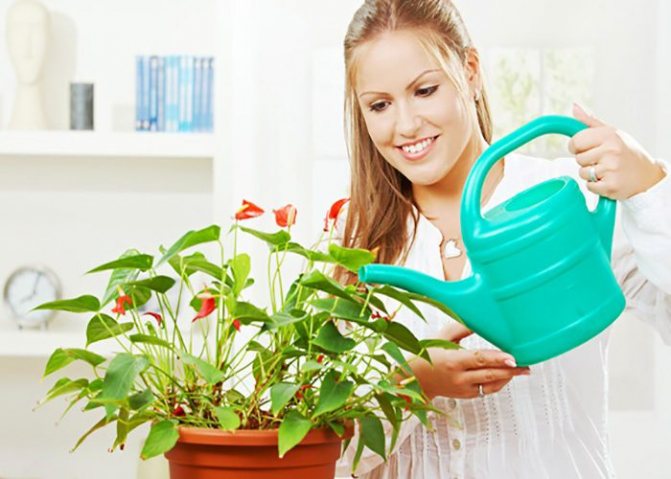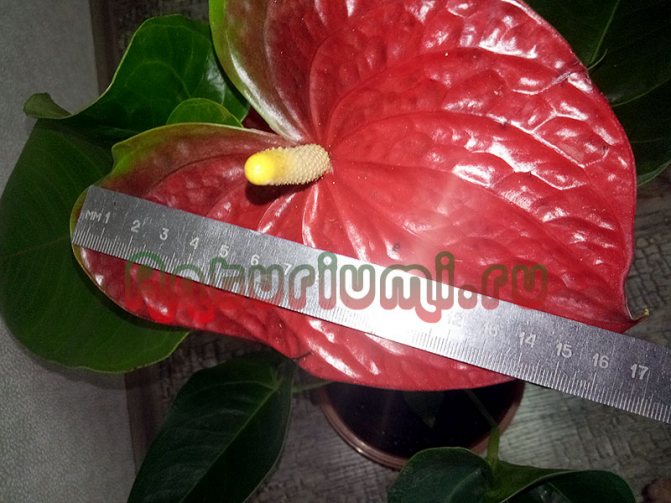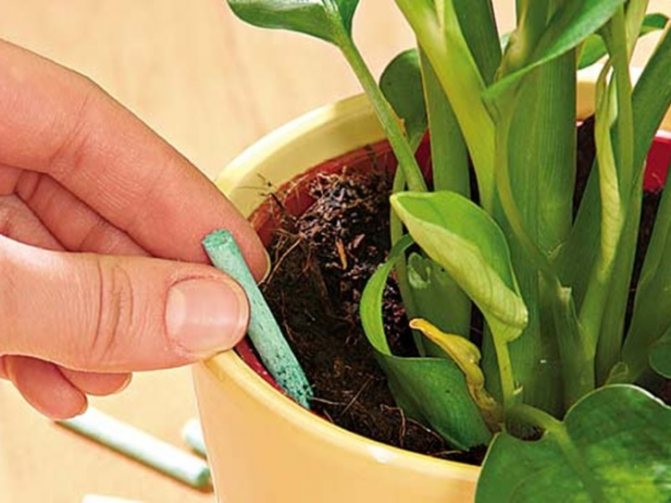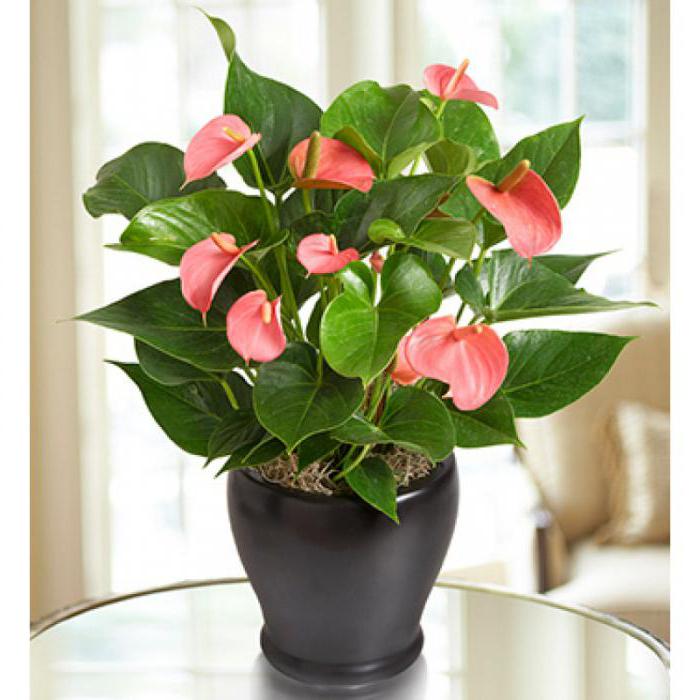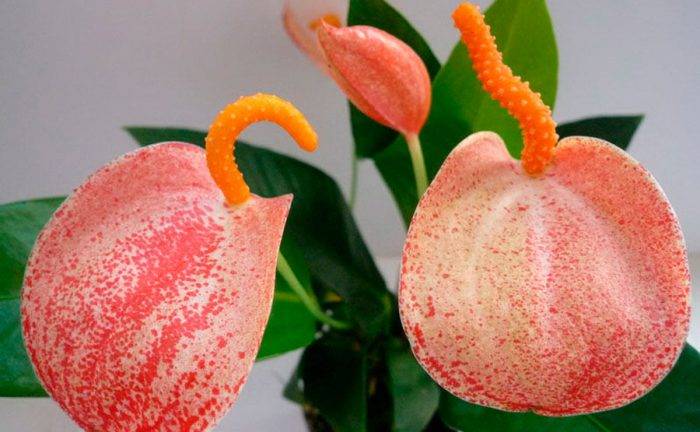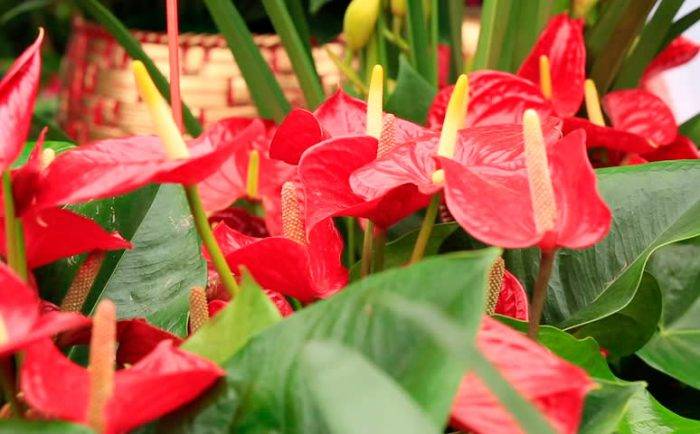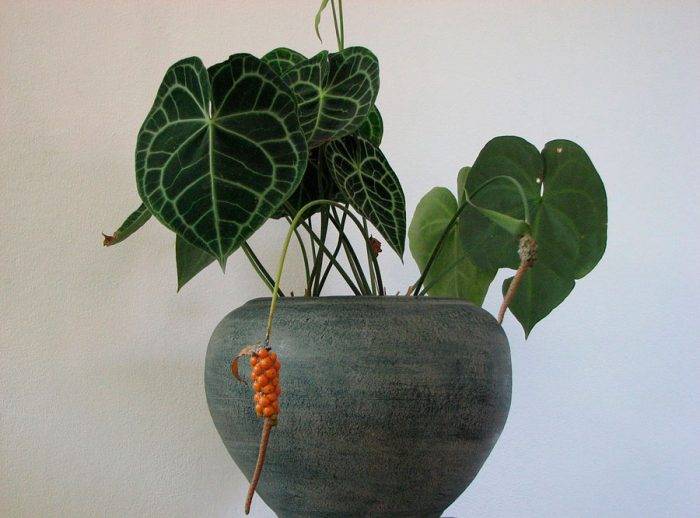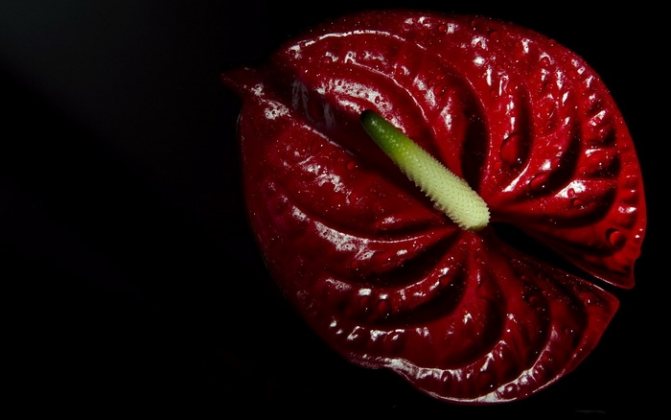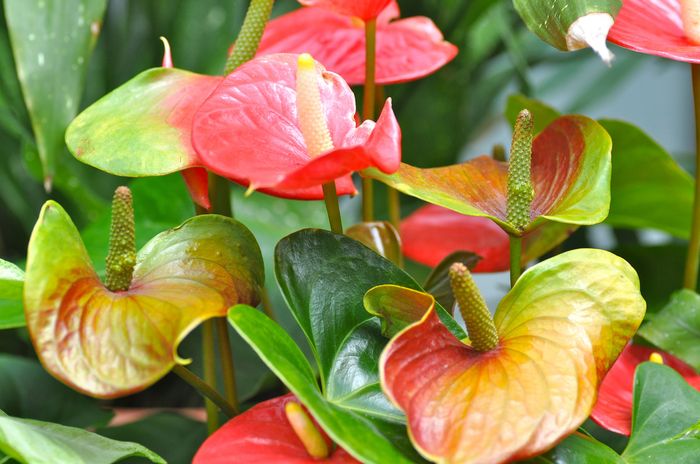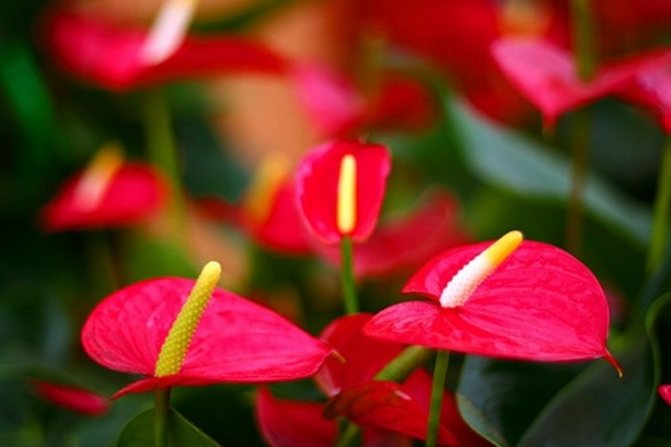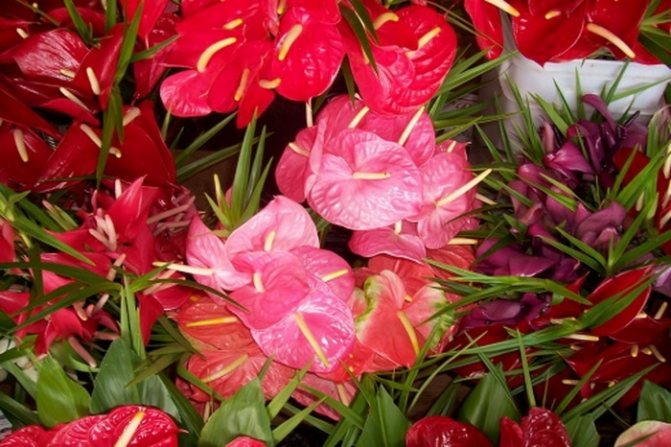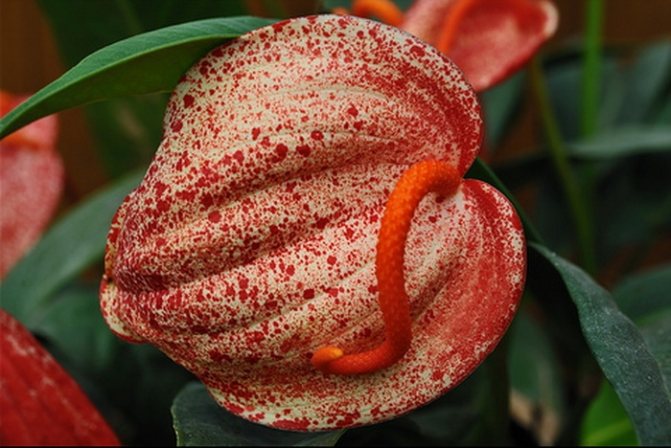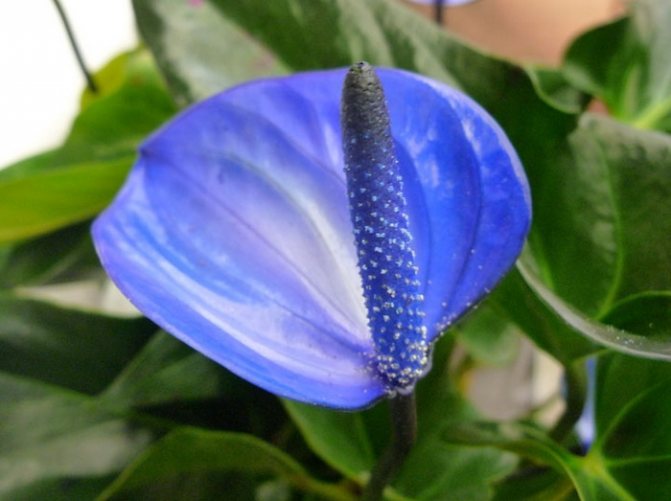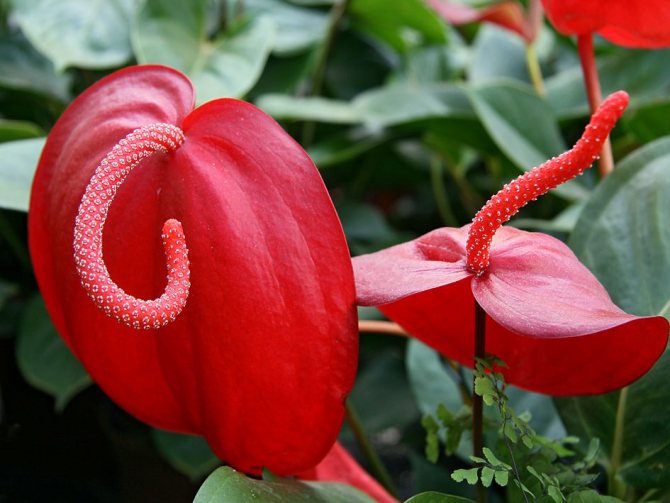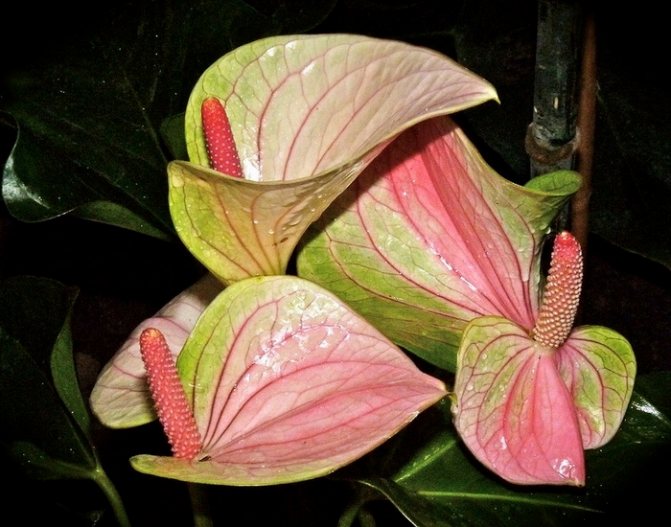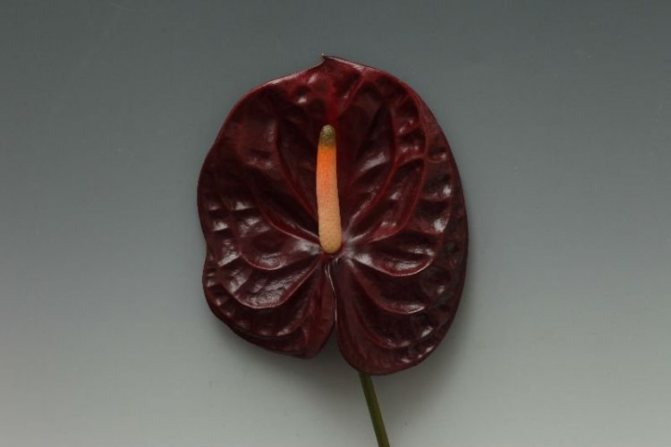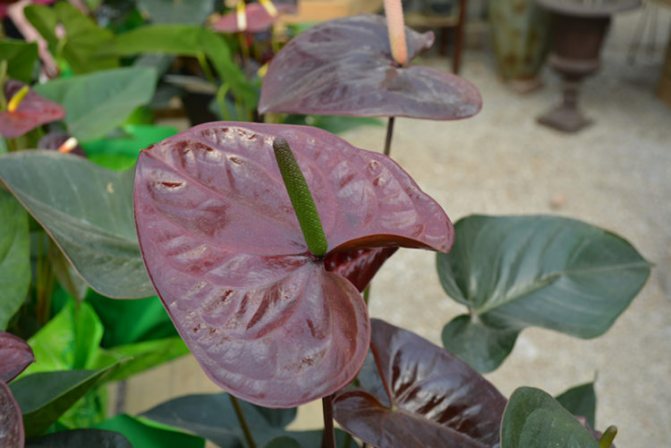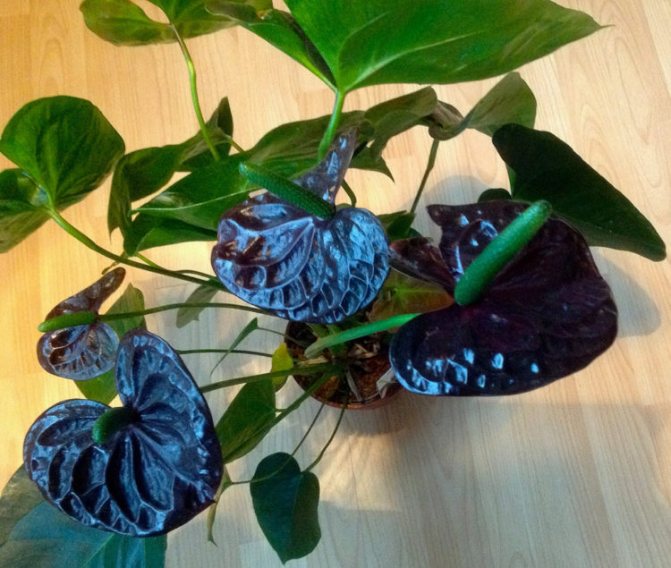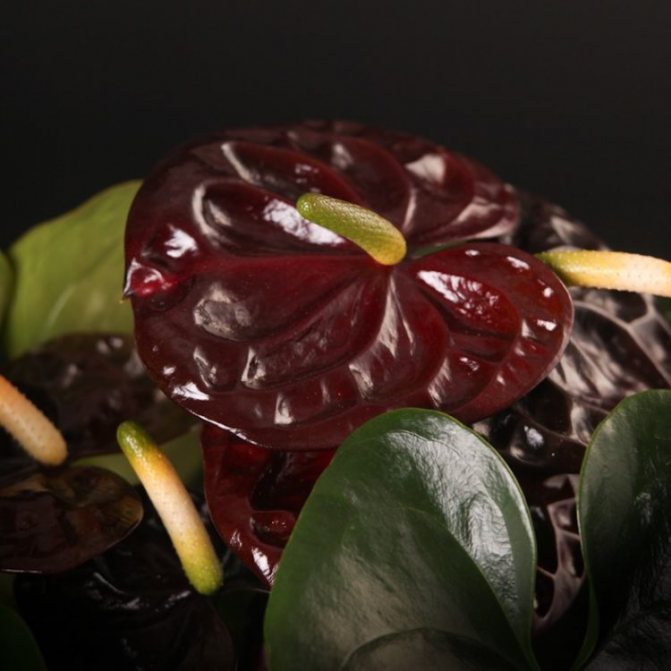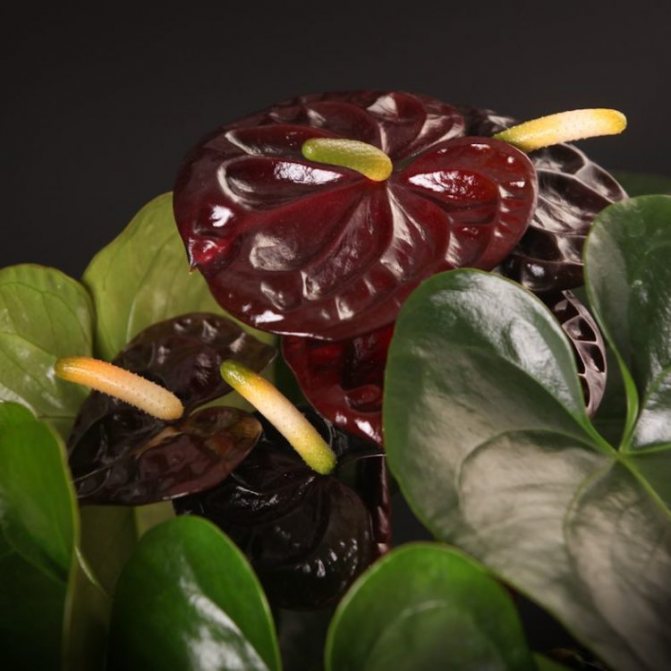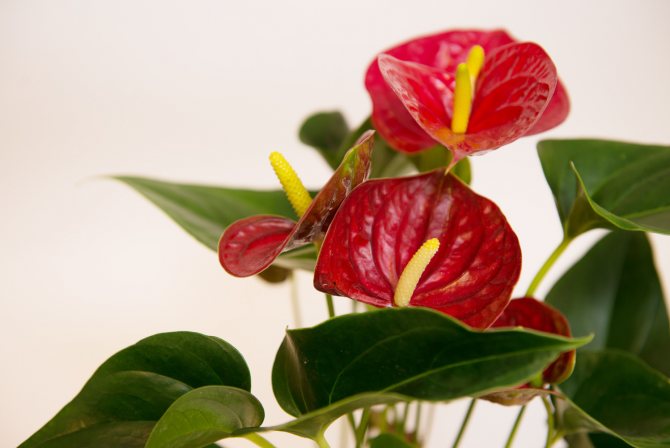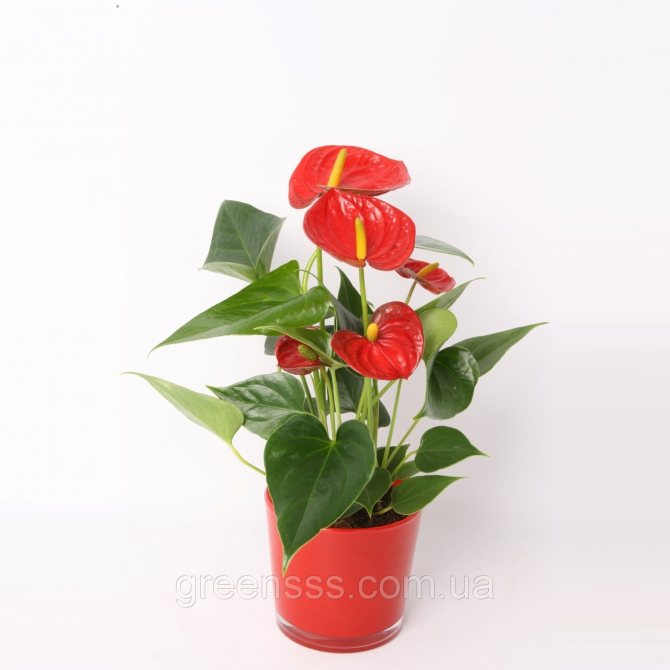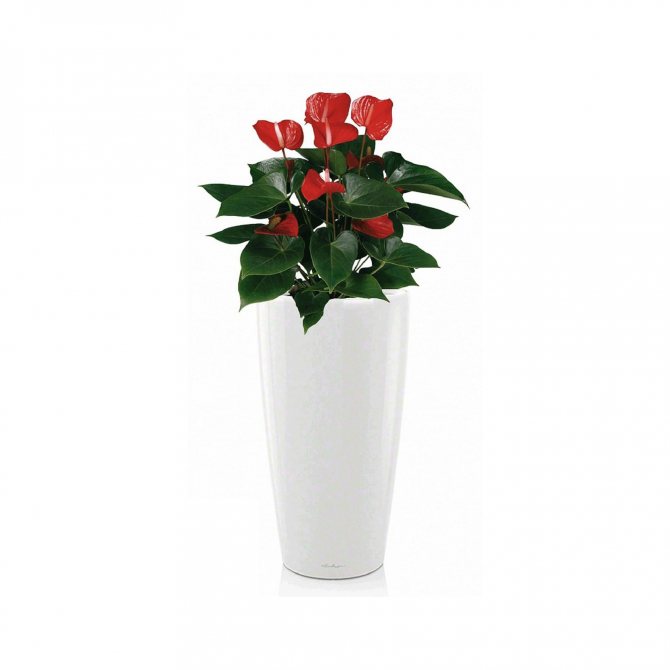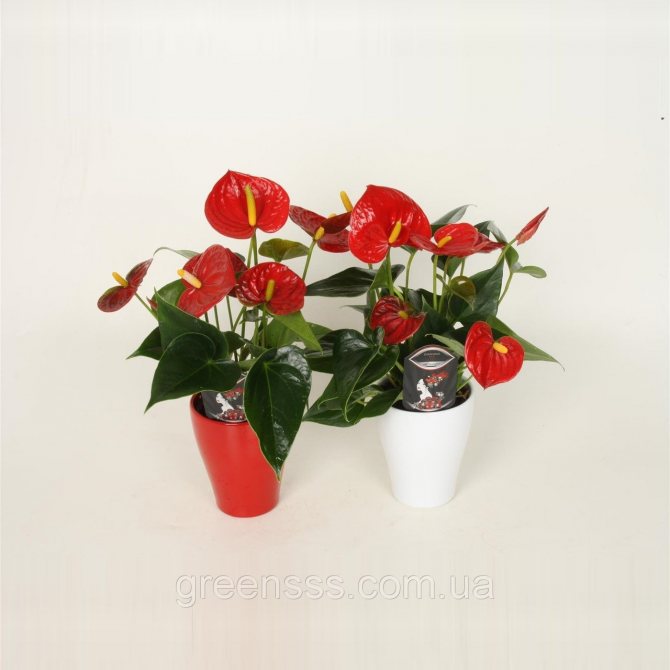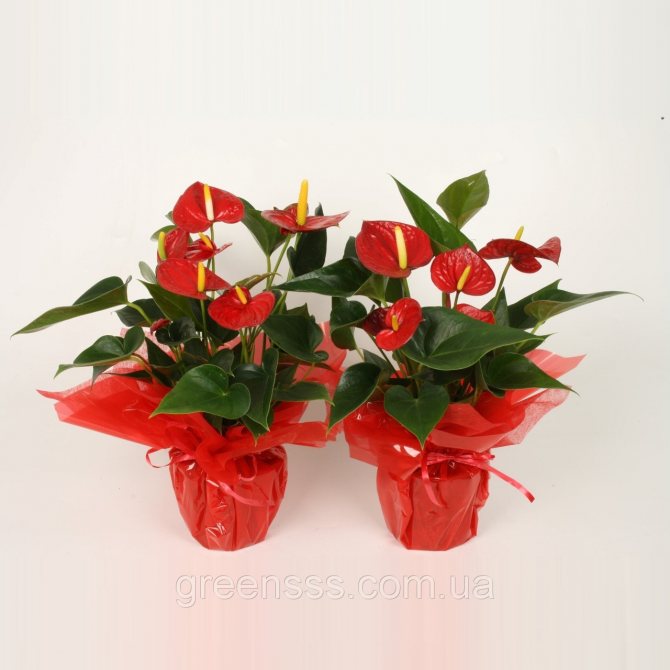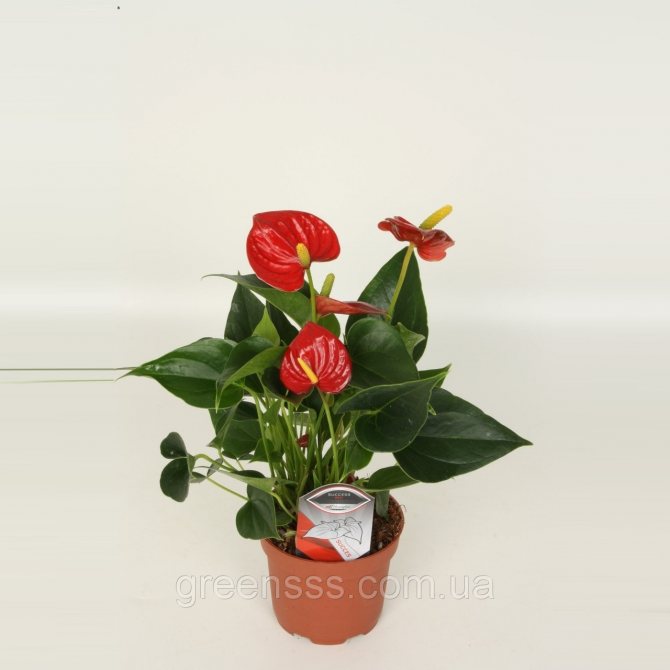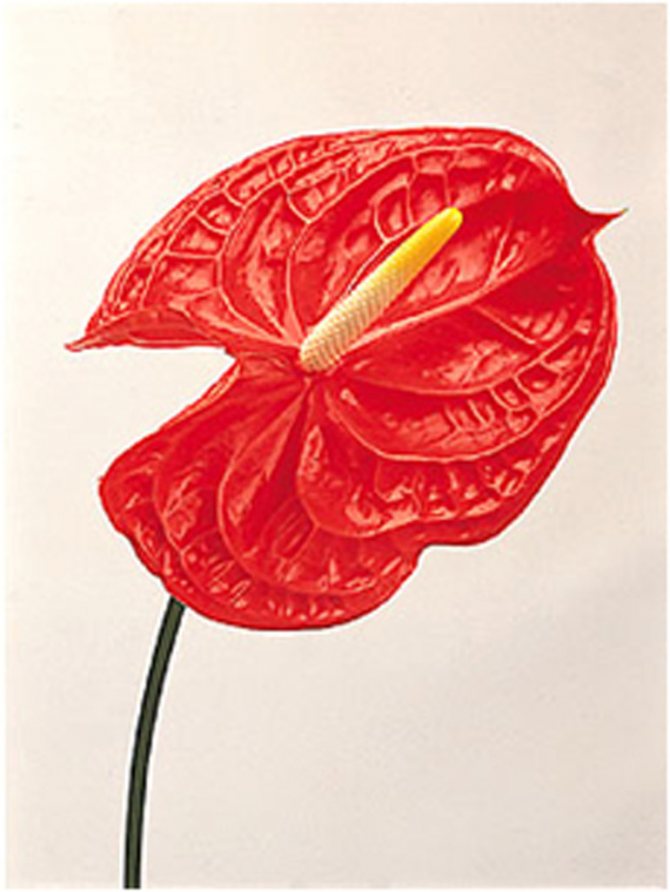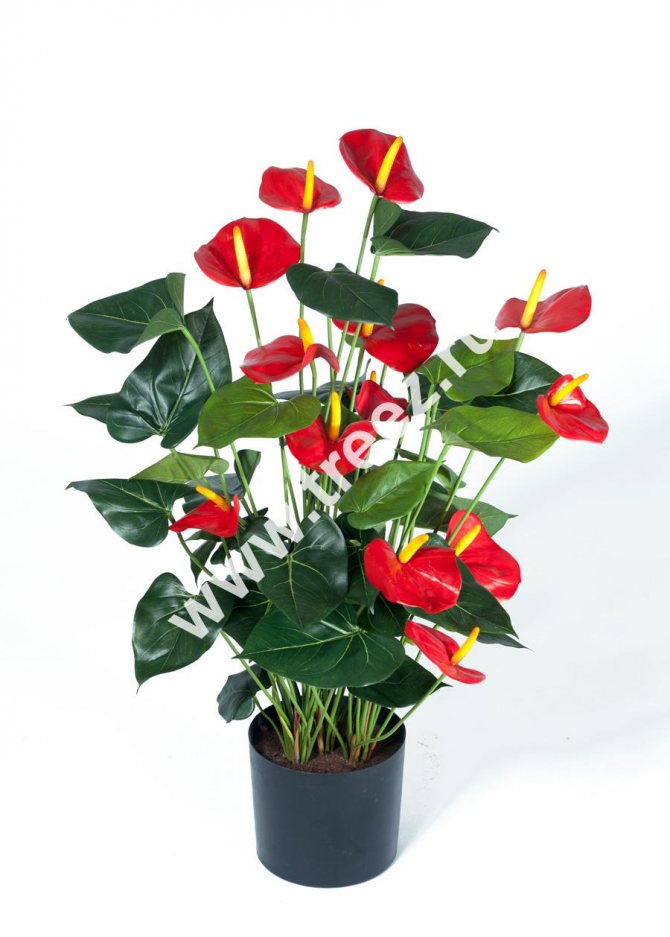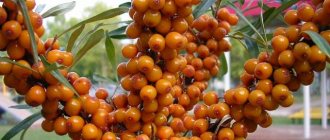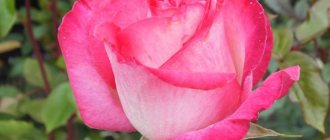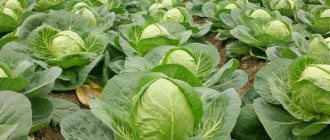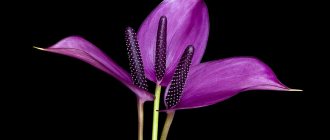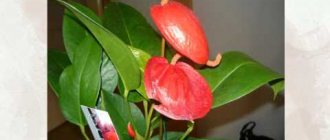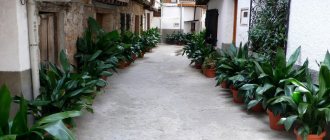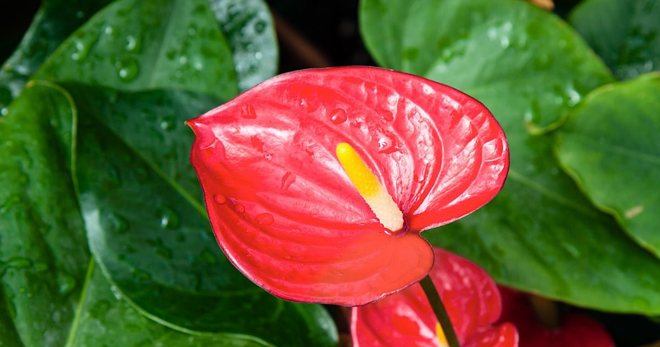
The anthurium flower surprisingly combines the beauty of green and flowering indoor plants. With proper care and constant regular watering, it will delight you with spectacular flowering. There are many color schemes, original varieties with a beautiful green mass.
Anthurium varieties Andre and Scherzer in color
The most common and widespread type of anthurium is the red Andre Anthurium. Anthurium varieties red (Anthurium Red) attracts with its brightness and energy. It is good to use it as a gift for a loved one. Catalog number is 1.
This form of the plant was bred with the participation of the two most popular flowering species of "male happiness" Andre and Scherzer. Varieties have been bred with different color of the bedspread: from milky white to rich red, as well as pink, greenish and orange.
Anthurium mix grows up to 80 cm in height, on average 50-70 cm. According to the idea of breeders, the hybrid should be more unpretentious to growing at home. In the opinion of florists, its "flowers" are better suited for cutting into bouquets.
There are a huge number of hybrid forms of "male happiness" and every day there are more and more of them. We present the most popular and affordable varieties of anthurium Andre and Scherzer with names and photos, as well as indicate less common forms.
The most popular white varieties: "Champion White" (White champion, white champion), "Sumi" (Sumi). White-pink: "Princess Amalia Elegance" (Princess Amalia Elegance).
Red
The most famous red varieties: "Dakota" (Dakota), "Sierra Magic" (Sierra magic), "Turenza (Perfectred)" (Turenza).
Red-green: anthurium adrianum "Baby Boom" (Baby Boomer).
Others: Almera, Bugatti Veyron, Champion Red, Dynamite Red, Red King, Royal Champion "(Royal champion)," Success Red "(Success ed).
Orange variety: "Picasso Orange" (Picasso orange).
Orange-red kits: Baby Orange, Madural Orange, and Princess Orange.
Pink
Pink varieties: Joli, Lady Love, Pink Alabama and Pink Champion.
Other forms: "Picasso Pink" (Picasso pink, pink), "Pink King" (Pink king), "Pink Queen" (Pink queen).
Pink-green: "Fantasy Love", "Leganza" (Leganza), "Pandola" (Pandola).
Purple (lilac or lilac)
Purple varieties: Cavalli Purple, Fiorino and Utah. Also an interesting option: "Picasso Purple" (Picasso purple).
Blue and blue anthurium: dyed or not?
“Male happiness” does not have a blue or blue color gene (pigment), therefore, it is impossible to breed a variety with a similar color of the bedspread. According to the specialists of the Faculty of Biology of Moscow State University, the samples presented to date are colored flowers with the help of injections of special ink into the peduncle.
For example, the Dutch one offers a blue anthurium variety "Princess Alexia Blue" (Princess Alexia blue) and a bright yellow flower "Princess Alexia Yellow" using this technology. Known blue variety: "Picasso Blue".
Yellow
"Picasso Yellow" (Picasso yellow), "Princess Alexia Yellow" (Princess Alexia yellow), "Vanilla" (Vanilla, vanilla).
Green
Baby Green, Green King, Midori, Picasso Green.
Black (chocolate)
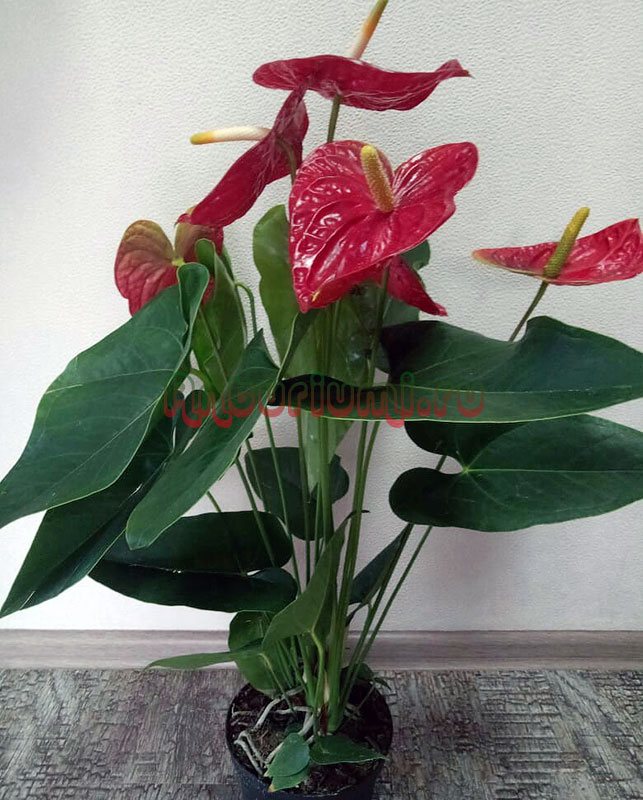

The most popular black varieties are BlackBeauty, Black Queen and Otazu.
More rare varieties: "Black Dragon" (Black dragon, black dragon), "BlackLove" (Black love, black love).
This type of "male happiness" is the most popular basis for the development of new hybrid varieties. For photos of the most famous varieties of Anthurium Andreanum, see the previous chapter - for different colors.
Here we list the names of the 10 most common flower shapes in alphabetical order.
"Baby Boom" (Baby Boomer), "Cavalli" (Cavalli), "Champion" (white, red, pink), "Dakota" (Dakota), "Fiorino" (Fiorino), "Princess Alexia Blue" ), Princess Amalia Elegance, Sierra Magic, Turenza and Utah.
1. HOW CORRECT TO CARE FOR ANTHURIUM?
2. SECRETS OF A SUCCESSFUL TRANSFER OF "MAN'S HAPPINESS"!
3. ANTHURIUM REPRODUCTION - THE BEST WAYS!
4. PROBLEMS WITH LEAVES IN "MEN'S HAPPINESS" AND DISEASE!
5. WHY DOES NOT ANTHURIUM COLOR? WHAT TO DO?
6. ABOUT THE USE OF THE PLANT: HOME FLOWERS FOR FAMILY WELL-BEING AND STRONG LOVE!
We wish you to choose your favorite type or variety of flower, and so that it pleases you for a long, long time!
Palm transplant
How to care for a yucca during a transplant? The plant does not require special care at this time. The palm tree is rarely transplanted, after two to three years, with the onset of spring. To do this, use a deep pot with a heavy nutrient mixture. The leaves of the plant are cut off by half. The roots are soaked for an hour in boiled cooled water, to which crushed coal is added. After planting, the yucca is well watered. There is no need to feed the plant during transplantation. Do not forget, for each subsequent transplant, you need to take a larger pot. The size of the overgrown roots should be taken into account.
Anthurium care Dakota


Anthurium andrianum can have a very diverse leaf shape (depending on the species to which this or that specimen belongs). For example, heart-shaped, oval, spatulate, bifurcated. Leaves can have both matte and glossy surfaces.
However, the most eye-catching part of the plant is, of course, the "flower", which can be found in various shades - from bright scarlet to snow-white or green. The inflorescence itself can be in the form of a ball, spiral, cone, and the flowers can be in the form of a square or a rhombus. The scent also varies and can range from delicate to bright, intense aromas, as well as exude a stench.
If the room is light enough, then anthurium flowers can bloom throughout the year, while each flower is kept for more than 30 days. Pollination produces fruits in the form of yellow or orange berries with seeds inside.
Also, anthuriums are not alien to aging, the onset of which can be determined by the shrinking of the leaves, the dryness of the trunk. However, this process is reversible, since it can be "rejuvenated". A spectacular outwardly flower often becomes a decoration of home interiors and office premises.
Home care for this plant is not difficult at all, especially if you know the important nuances. These include:
- High quality lighting. In this case, the light should be not only bright, but also diffused. Since a direct ray of light falling directly on the leaves, on the contrary, will negatively affect the condition of the flower.
- Stable temperature. Anthurium Dakota prefers a mild climate. In summer, the temperature should be constant, without sudden fluctuations, on average 25 ° C. If the room thermometer falls below 20C, the plant may get sick. In winter, temperatures of 17 ° C are preferred for most species.
- Lack of drafts. Since the Dakota anthurium is native to the tropics of America, it is very afraid of drafts. This danger should be carefully avoided in order to keep it healthy and blooming for years to come.
- Regular watering. It is important to monitor the quality of the water, since tap water is strongly discouraged. It is best to use settled rainwater, as it has a softer effect on the roots and does not contribute to the roughness of the soil. When watering, the water should not fall on the trunk and leaves; it is best to direct the stream into the ground. In winter, watering is required once a week, in summer - two. Try not to flood the anthurium, as it does not like excessive moisture, to which it reacts by rotting the roots.
Anthurium Dakota requires mandatory fertilization, which is best done at the end of the spring months. However, if he is sick, you should refrain from feeding. There is no need to prune the leaves; instead, it is better to cut off the wilted buds, which will make the rest of the flowers look stronger and last longer.
A large number of representatives of the class are epiphytes, which implies special requirements in the home environment. A huge number of anthuriums reproduce well in greenhouses.
A domestic tree requires frequent watering, which requires the surface layer of the earth to dry out. It is not recommended to allow the soil to dry out. To achieve a wild bloom in winter, it is necessary to reduce watering by 20%, and maintain a room temperature of at least 18 ° C. Watering is recommended with filtered water.
For cultivation, it is necessary to use loose soil, which conducts oxygen and absorbs water well with a low reaction (pH 5.0-6.0). The composition of the substrate should include large particles, thanks to which the plant will be stable and retain useful substances. With all this, the composition of the soil should not be compacted, decomposed. At the bottom of the flowerpot, it is necessary to lay drainage, sand composition and cuttings. The collection of the substrate includes moss, wood, peat, charcoal, coniferous bark.
The plant loves diffused lighting, and tolerates partial shade normally. Anthurium must be protected from direct rays. Considering the area of the home interior, the plant will feel comfortable on the west and east sides.
Absolutely all representatives of the species need a uniform temperature regime throughout the year. In the summer season, the optimum temperature for the plant is 18–20 ° C. It is necessary to protect the exotic from drafts. During the period from autumn to spring, a temperature of at least 16 ° C must be maintained. Only hybrids of the Scherzer variety need a cool place for bud formation. Early flowering can be achieved with a gradual increase in temperature to 25 ° C.
Anthurium transplant
Adult plants need to be transplanted as needed, which is associated with the small size of the pot. And young ones need to be transplanted once a year. When transplanting, you must carefully handle the foliage and root system. After transplanting, the flower is tied to a support for stability. During the rooting period, the plant needs to be watered frequently, sprayed and protected from the sun.
Where is the best place to place a palm tree
Yucca is considered an unpretentious plant that perfectly adapts to home conditions. She calmly reacts to dry indoor air, which is not typical for all indoor flowers. In summer, it can be placed on the balcony or taken out into the garden. First, put in the shade, and when it gets used to, choose a sunny spot for the plant.
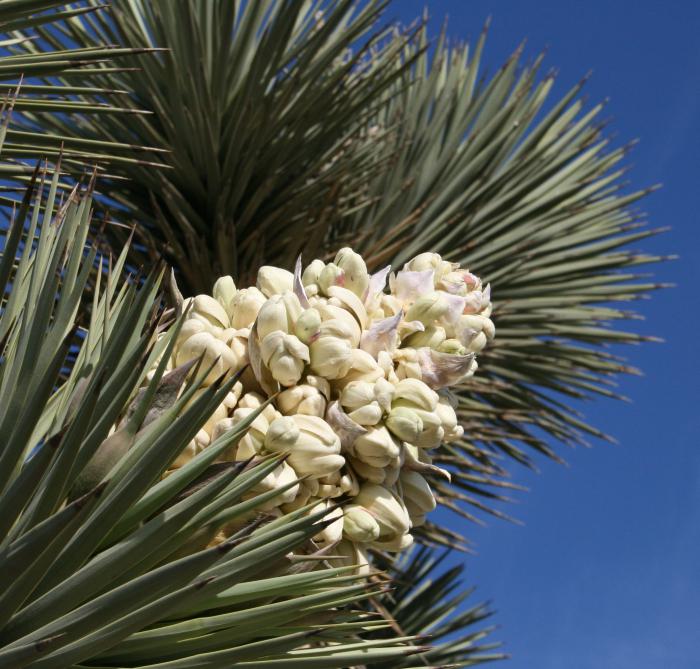

Yucca palm loves the sun and is not afraid of direct rays. In winter, it is better to set aside a corner for it on the south side so that the palm tree receives more light. And in summer - from the east or west, in order to avoid the refractive rays of the sun, from which there may be a burn on the leaves.
Anthurium Black Love
A very attractive anthurium variety. The translation of the name of this anthurium variety means black love. A good choice for a gift for a man. Catalog number - 2.
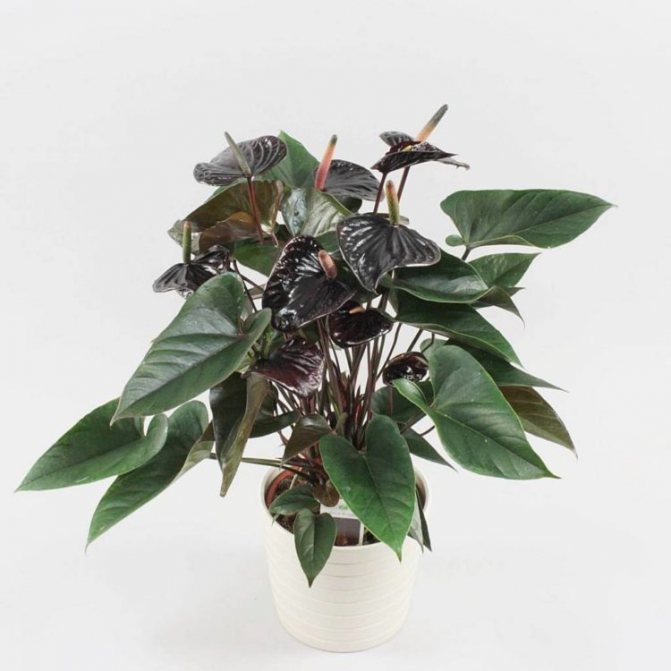

A video of the flowering of this anthurium variety has appeared on our YouTube channel.
Anthurium Black Beauty is one of the most spectacular anthurium varieties.Black anthurium flowers are quite rare and are highly prized by anthurium lovers. In contrast to the Black Queen anthurium with a rounded shape of the bedspread, Black Beauty has a pointed bedspread and a small black ear. Catalog number - 17.
Anthurium video Black Beauty.
Who is recommended to keep “male happiness” in the house?
A huge number of plants affect the atmosphere of the home, have many signs and superstitions. Anthurium is one of those. He's just shrouded in mystical stories.
Some experts argue that the blue anthurium flower is more suitable for the male sex. Signs and superstitions say the opposite - the color of the flower does not matter, the main thing is the physical condition and external health of the plant. So you can safely purchase a red, white and even pink flower.
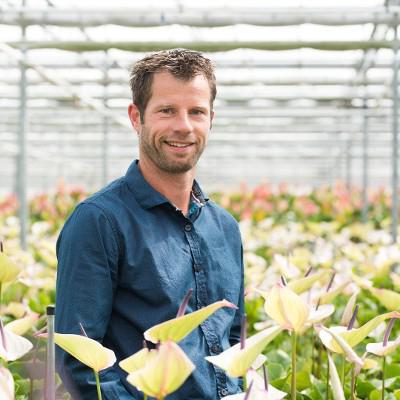

Anthurium has the greatest magical power during its flowering.
Household representatives of such plants bloom infrequently. Anthurium bloomed - a good omen, this is a sign of fate - for the head of the family, and often for all household members, a white streak comes.
Also, a flower donated by someone will bring much more benefit than a flower bought by a man himself.
It is recommended to have it at home for couples with a quick temper and excessive emotionality. Anthurium is able to absorb the negativity that is in the air of the room, thereby bringing harmony and happiness to the house.
Buy rooted baby or blooming anthurium
Anthurium is an evergreen plant from the Aroid family. This exotic flower is an epiphyte in its natural environment. Fruits in juicy, fleshy berries that contain many seeds. The plant is perennial and fast-growing. The flowers are bisexual.
All Anthuriums, including Black, are called "male happiness" in Russia. It is believed that this plant endows the owner with courage, passion and vigor.
And in South America, where the flower comes from, the names are no less poetic: the flamingo flower, the flower of love. Latin name Anthurium Black.
The plant has thick, often shortened stems, 15-30 centimeters long. The leaves are located at the ends of the stems, their surface is glossy. The inflorescence is presented in the form of an ear, on which the flowers are located.
Black Love has elongated glossy dark green leaves. At first, the ear is light, but as it ripens, it turns black and becomes almost invisible against the background of a dark blanket. Black Love bedspreads with burgundy tint. They are heart-shaped and reach 15 centimeters across.
A distinctive feature of the Beauty Black variety is the tulip-shaped form of the bedspread and the rich dark green color of the foliage, on the back of which bright burgundy veins are noticeable. It can grow in height up to 65 centimeters. The color changes as it ripens from maroon to black with a burgundy hue.
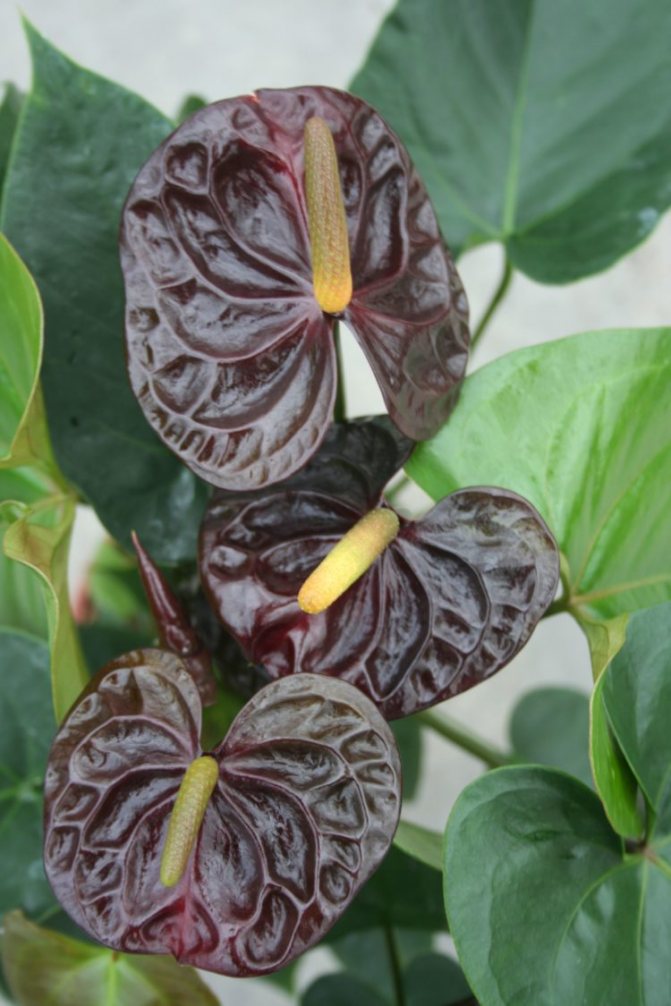

Large Anthurium. In height, the Black Princess reaches 80 centimeters. With the ripening of the flower, the veil changes color from cherry to black with a reddish tint. A light ear looks spectacular against the background of a black bedspread. The leaves are dark green, leathery, heart-shaped.
A rather rare variety, but no less beautiful. It reaches a height of 50 centimeters. The bedspread has a glossy surface and is painted in a characteristic chocolate shade. The ear is light, but darkens as the plant matures. Leaves are leathery, deep green.
There are several varieties of black colors that are also amazing and pleasing to the eye:
- Black tulips Queen of the Night. In addition to their unusual beauty, they are also very hardy and unpretentious.
- The Onyx Odyssey hellebore is prized for its rich maroon hue. It is a perennial plant that can be grown in pots.
- Calla Black Star resembles Anthurium not only in color, but also in the shape of the bedspread.
- Coleus of the Black Prince variety takes up little space in a flower pot, but will delight its owner with a rich black and red color.
- Another black petal plant that can also be potted is Molly Sanderson's viola. This beauty blooms from spring to autumn.
The exotic beauty of black Anthuriums will adorn the collection of any plant breeder. In addition, with proper care, the plant can bloom all year round.
You can buy one blooming Anthurium, depending on the variety and age of the flower, in the range from 500 to 1000 rubles. An rooted shoot (little baby) of anthurium can be bought for 200 rubles. Delivery by mail is free if the cost of the ordered plants (a set of any seedlings or seeds ) is 3000 rubles. The minimum purchase amount is 1000 rubles.
When choosing anthuriums, instead of the name, you can indicate the number of the flower in the photo.
Anthurium's appearance is very effective. The leaves are large, leathery, of various types and sizes - incised, whole, from a few centimeters to one meter in length. The leafy part temptingly plays with a velvety sheen, with a silvery gloss on the veins. Many plant groups have large leaves and ornamental patterns.
Flowers of a tempting and extraordinary colorful palette, collected in a close inflorescence - a tail-shaped or tubular cob. The name of the genus comes from the Greek language "anthos" - flower, "oura" - tail.
The ear is endowed with an inflorescence veil, which in some species is small, green, brightly colored and shining. Other regions call anthurium Pink Flamingos. The flower fades to form juicy berries that completely cover the ear.
Types of garden anthuriums are widespread in culture, and are considered one of the leaders of the Aroid genus, primarily as a flower that is used to create bouquets. There are 30 genera and more than 50 hybrid forms in the global commercial trade.
Anthurium is quite capricious and difficult to grow at home. Most species are intended to be grown only in designated greenhouses. Flowers are bred for bouquets and as a decorative element.
Is it possible to keep anthurium at home?
The plant belongs to the Aroid family, and, like all representatives, contains calcium oxalate, which can irritate the mucous membranes of the eyes, mouth and skin. Some people may be allergic to pollen.
It is not recommended to taste the leaves of anthurium, as it is considered a slightly toxic flower.
That is why, with extreme care, you need to choose the location of the flowerpot in the house where small children and animals live.
Anthurium cleans the indoor air from harmful substances such as xylene and toluene. In addition, the plant needs high humidity, which benefits all the inhabitants of the room.
Anthurium Flamingo Pink
The delicate pink color of the bedspread and the dark juicy purple color of the cob (flower) distinguish this type of anthurium. Probably everyone will like this combination of colors. So such a flower can be safely used as a gift. Catalog number is 4.
Video of the anthurium Flamingo Pink blooming in January.
Anthurium Pink Pandola will become one of the main decorations of your room. Buy a rooted sapling of a plant, and in a year this sprout will turn into a rather large bush. Catalog number is 7.
Anthurium Prince Of Orange has a rare orange shade of bedspread. The light green ear has a yellow top. The catalog number is 16.
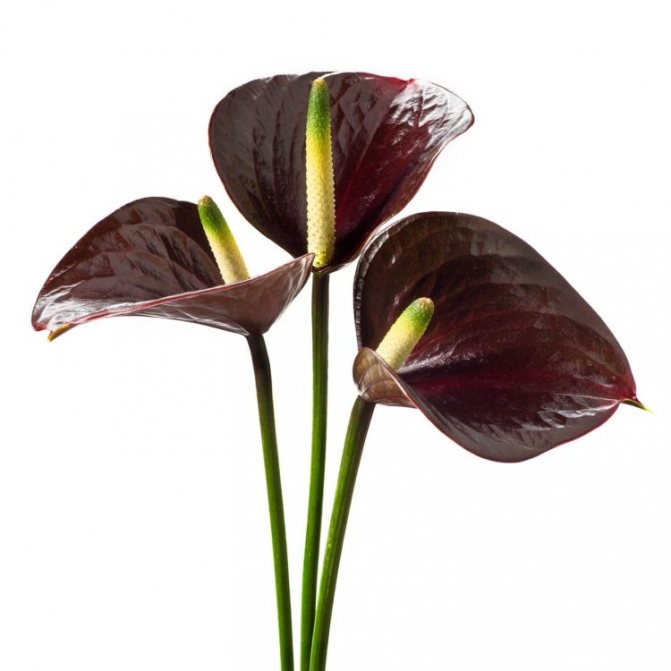

In this video, you can appreciate the beauty of the Prince Orange anthurium flower in detail. Subscribe to my channel and you will be aware of all the new products.
This anthurium variety is distinguished by its large flower and leaves. An unusual combination of orange and green color distinguishes this flower from other anthuriums.In the midst of flowering, this large anthurium bush, decorated with five or six flowers, looks very impressive. Catalog number - 18.
How does indoor palm reproduce?
At home, reproduction occurs by offspring, the removal of which will only benefit the tree. If you take care of the yucca correctly and regularly, it will give new plants in the first year. For the normal development of a palm tree, up to five processes are left on the trunk. If removed offspring are planted in wet sand, they will form roots after a couple of months. In this case, there should be high humidity and a temperature of at least 20 degrees.
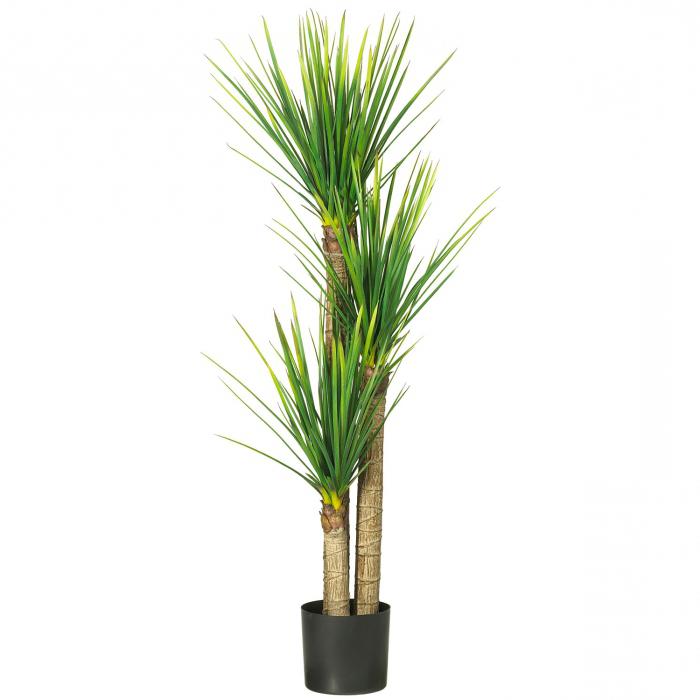

Very often, the yucca palm, the photo of which you see, has one trunk. To achieve its branching, in spring or summer you need to cut off the top so that leaves remain on it. The length of the cutting should be 5-10 cm. The cut area is immediately sprinkled with crushed coal. This prevents the spread of bacteria. After a while, shoots will grow on the trunk. Over time, they will grow stronger and turn into trunks.
The cut stalk is rooted. To do this, dry the cut, leaving it in the air for two hours. Then they are planted in wet sand or cooled boiled water. When the roots appear, the yucca can be planted in a pot of soil.
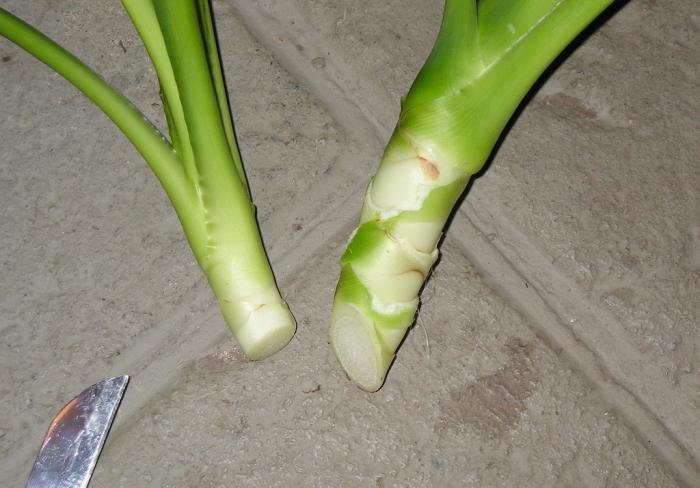

A yucca palm tree can grow from a small piece of the trunk. To do this, put it horizontally in a pot of wet sand. After a while, the sleeping buds on the trunk will wake up, new shoots with roots will grow from them. They are planted in separate pots.
History of origin and geography of habitation
Anthurium, like many other tropical plants, was described in the 19th century while studying the flora and fauna of South America. This flower was discovered by Eduard Degas, after which the beautiful plant became popular in Europe. Black anthuriums were bred by breeders who tried to add even more decorativeness to the already exotic flower. Anthurium mainly grows in the tropics and subtropics of South America. The northern border of its distribution is in Mexico, and the southern border is in Paraguay.
Anthurium for the fair half. Signs
For women, anthurium also carries some information and help. The flower's action is aimed at smoothing corners and eliminating conflict situations.
It is recommended to give this flower to a girl who wants to get married. If she places a flowerpot in her bedroom next to the bed, then he will lure the groom to her. And, by the way, the future spouse will be a very worthy person.
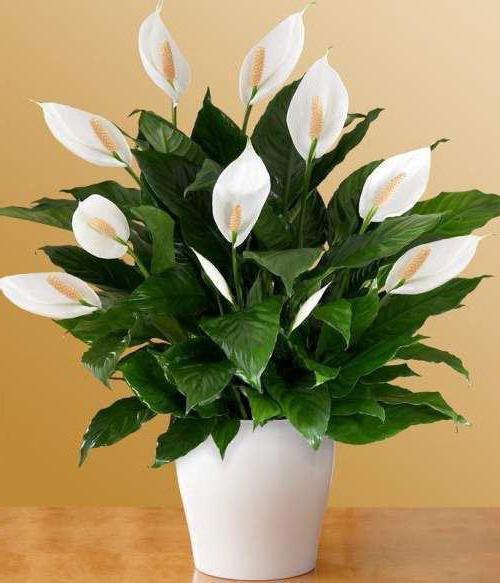

If the action of the anthurium has already worked, then the girl who got married or started living with a young man needs to acquire another flower that acts as an ally of the anthurium - spathiphyllum. This plant is also called "female happiness", and its action is to supplement and enhance the magic of anthurium. Photos of these plants are presented below.
Anthurium: how to care properly
Anthuriums are undeservedly considered capricious plants. But for a comfortable content, they just need to create a warm and humid environment.
- Temperature. In the warm season, the optimal temperature range is 22-28 ° C.
- Watering. These plants are watered a couple of times a week during the period of active growth. It is necessary to monitor the moisture content of the soil in the pot and prevent it from drying out. In the morning, it is better to additionally spray the plant to create increased humidity.
Anthuriums cannot accumulate and retain liquid, therefore watering and maintaining the correct moisture level is vital for them. - Shine. Anthuriums do not like direct sunlight, so east or west windows would be a good option for them.
- Priming. Loose, light soil that conducts air is good. Be sure to include large particles. You can make the soil mixture yourself by mixing peat, chopped moss and turf in a 2: 2: 1 ratio.You can try another option: rough-fiber deciduous soil, chopped bog moss and light turf soil in a ratio of 2: 1: 1.
- Cropping:
- it is necessary to cut off the peduncle after flowering;
leaves if there are too many of them or they are dry or damaged;
- lateral shoots with abundant growth.
- Top dressing. Top dressing should be applied twice a month.
Anthuriums are sensitive to an excess of mineral salts, therefore, fertilizers must be diluted. - Pot. For Anthuriums, plastic pots are better suited, since the soil temperature in them will not be lower than the air temperature. The container should be tall and narrow.
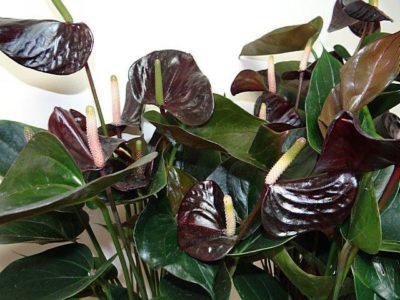

Transfer. The transplant is usually carried out from February to March during the period of plant growth. Adult plants need this procedure every 2-4 years.- You need to prepare a new container: make drainage at the bottom, pour a small layer of soil on top and moisten it a little.
Gently remove the flower from the pot.
- Place Anthurium in a new pot so that its aerial roots are a couple of centimeters lower than the previous position.
- Top up the soil in such a way that the root collar is hidden under a two-centimeter layer of soil mixture.
- Water the flower in moderation.
- Shade the flower for 5-7 days.
- Wintering. In the cold season, the plant must maintain a temperature in the range of 15-16 ° C. Watering should be done more moderately, about 1 time per week and a half. It is also better to refuse feeding. In winter, it is necessary to use fluorescent lamps, since the daylight hours of Anthurium are at least ten hours.
It is better to choose a pruner as a tool, rather than a large garden shears.
You cannot cut the roots of the plant, as this is the most fragile part of the Anthurium.
It is necessary to work with gloves, as the flower contains substances that cause skin irritation.
Although anthurium is often called “male happiness” (it is generally believed that it brings freedom, courage, strength and passion for women, therefore it is customary to give it to men), it only has a name from the strong half. A blooming, healthy flower is a reward for patience and hard work, because caring for an anthurium at home is very troublesome. So, what will the indoor anthurium require from its owner:
- temperature - for a tropical guest, the optimal temperature will be in the range of 25-27C (but no more, anthurium does not tolerate heat). In winter, it is allowed to lower the temperature to 18C (Scherzer's Anthurium will withstand 14C), but the temperature change should be very smooth, sudden temperature jumps (both up and down) will destroy the plant
- humidity - warm and humid - these are the main components of the normal development of anthurium. Optimum humidity levels are 70-85%, so you can't do without a humidifier, especially in winter. You can put the plant in a tray with water (but at the same time the pot itself should be above the level of the liquid, not in contact with it) and spray the leaves twice a day (morning and evening)
- watering - anthuriums are very capricious and sensitive to the watering regime, but it is still better to “underfill than overflow”. On stagnation of water in the ground, the plant immediately reacts with diseases. An indicator of the need for watering - the soil is half the pot dry. For watering, they take warm, well-separated (preferably rain) water, without lime impurities (the leaves begin to turn yellow from this), excess water that has seeped into the pan must be drained
- lighting - anthurium loves light, but direct sunlight is destructive for it. Therefore, it is preferable to place it on the east or west side, where there is enough diffused, soft light. On the northern windows, growth will be slowed down, and in winter it is better to rearrange it to the southern ones - a lack of light causes yellowing and leaf fall
- top dressing - during the period of active growth, as well as flowering, anthurium is fed 2 times a month, alternating mineral and organic fertilizers.It is very important to maintain the concentration - in comparison with the standard dose, they must be diluted twice as much
Whom to give?
Anthurium is a wonderful gift not only for a representative of the strong half of humanity, but also for a girl and even parents.
It is magicians who recommend giving this flowerpot to people with a melancholic type of nervous system or to those whose work is associated with constant nervous exhaustion and overstrain.
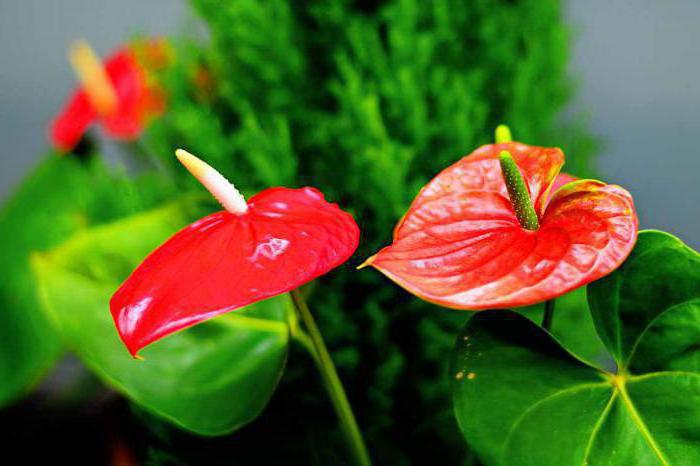

These flowers give joy and good mood to all household members.
Anthurium has a particularly positive effect on male strength and potency.
Reproduction
Anthurium reproduces:
- sections of the stem;
- air layering;
- children.
The most popular and effective breeding method for anthuriums is vegetative. To do this, you need to disconnect the young root from the root system and root it in soil saturated with sand and create a greenhouse, covering the flowerpot with transparent cellophane.
Seed propagation is less popular, as decorative properties are lost. Seeds germinate after 14 days on damp cotton wool at 24 ° C. They dive into loose soil after the leaves appear. After a dive, the seedlings need to be looked after and watered, as they germinate, dive a couple of times.
When growing anthurium, it is better to carry out reproduction vegetatively - by stem (apical) processes or by dividing plants. Young seedlings are carefully and carefully, because the leaves and root system of the plant are easily damaged, separated from the adult plant, the damaged areas are treated with charcoal and allowed to dry for an hour.
How to properly water a yucca?
Caring for indoor plants involves watering them. This should be done with a sense of proportion: the top layer of the earth should always dry out a few centimeters in depth. In excessively moist soil, the roots and base of the trunk will begin to rot, which can lead to the death of the plant. In summer and spring, it is enough to water the flower once a week.
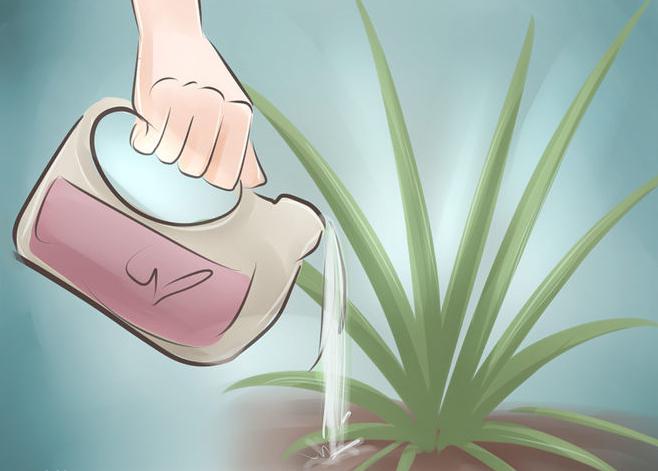

Spray the palm tree in extreme heat with warm water, every other day. In winter, you do not need to spray the plant; it is enough to wipe it after washing in a warm soapy solution. The room where the palm tree grows should be kept at a moderate temperature.
Anthurium Princess Amalia Elegance
The long and beautiful name Anthurium Princess Alexia Mosaic, like nothing else, perfectly characterizes this extraordinary flower. Catalog number - 8.
If you liked this anthurium variety, you can watch a short video of the flowering bush Alexia Mozaik on our YouTube channel.
Anthurium Princess Ariana has a medium-sized bedspread of deep purple color. The ear of this anthurium variety is also purple. Catalog number 11.
Anthurium Sweet Heart (Beloved) purple has not only the original name, but an unusual pink bedspread with a bright green border. The ear of this anthurium variety is also pink in color. Catalog number - 13.
Anthurium Princess Amalia Elegance has a bright pink bedspread with red veins. The tip of the coverlet is red, twisted downwards. The bedspread itself also collapses over time. The ear of anthurium is pink, evenly colored, catalog number 15.
Anthurium Princess Alexia Snow is a narrow-leaved species of anthurium with a white veil and a lilac cob. The white bedspread has a slight shade of lilac too, and the ear, on the contrary, has white areas. A very spectacular and beautiful variety of anthurium. Catalog number - 21.
Anthurium Fiorino is one of the most beloved and popular varieties of anthuriums. The magnificent and luxurious look of this flower is simply unique. Catalog number - 22.
Watch the video of the blooming anthurium Fiorino, and you will be convinced of it.
Help with financial difficulties
A large number of magicians and psychics claim that the flower "male happiness" not only helps a man in physical health and directs a woman to a wise path, it also attracts cash flows into the house.The coloring of the plant does not affect the omens. Anthurium pink works just as well as blue or red.
If there is a constant shortage of money in the family, then one of the ways to get rich is to get a pair of anthurium pots. The flowerpot color does not play a special role. More important is how the flower will be cared for. As the indoor beauty grows, the owner's wallet is replenished.
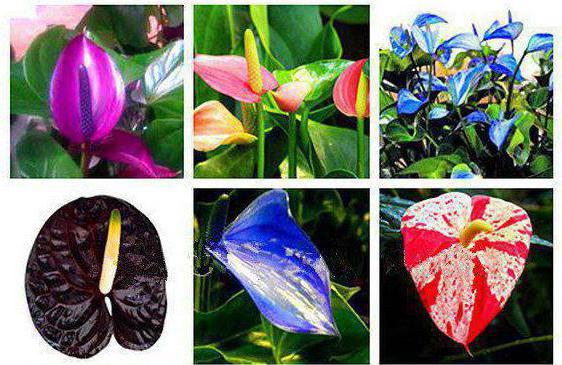

Diseases and pests
Anthurium is susceptible to both infectious and fungal diseases. Gray rot appears from high humidity. Contact with plants affected by anthracnose can lead to contamination of Anthurium.
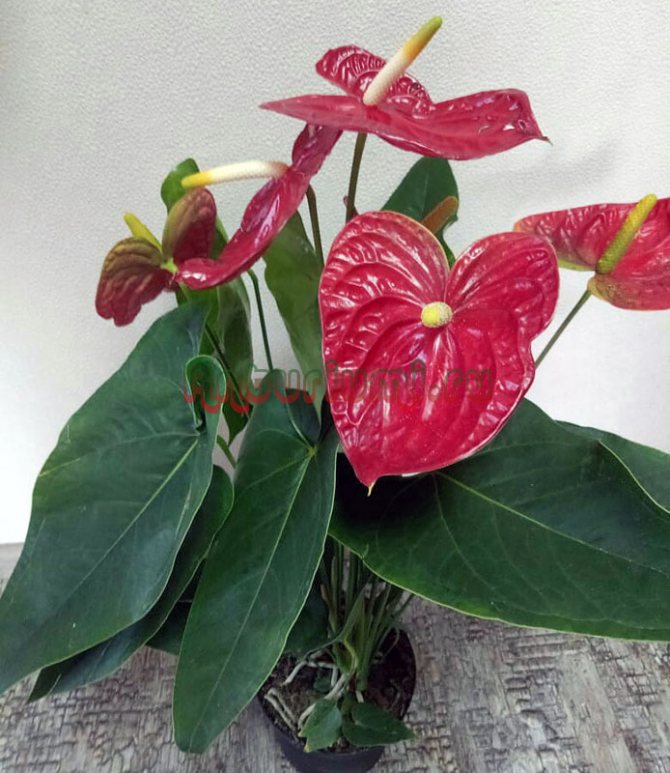

From pests to Anthurium, mealybugs, scale insects and aphids are dangerous.
Diseases affecting the flower are infectious and non-infectious. The initial group is often manifested through contact with other vegetation, especially in the Andre variety. The second group develops against the background of improper care. A gradual change in actions will help determine the error: watering, location and temperature. Among the pests that infect the plant, there may be scale insects, aphids, spider mites.
Anthurium reacts very sensitively to violation of the conditions of detention, about which an elegant and capricious plant will immediately make it clear:
- Anthurium leaves turn yellow when there is a lack of lighting (especially in winter) or when you get a sunburn, so it will be enough just to rearrange the flower to another place that is suitable for lighting. Other reasons may be prolonged excessive waterlogging of the soil, which could cause rotting of the roots. To prevent the spread of rot, the flower is removed, and the damaged roots are cut to healthy tissue. Another common reason for yellowing of leaves is chlorine in water, so the water must be defended in an open container so that the chlorine is completely weathered.
- Anthurium leaves dry, turn black and curl when the air is too dry, especially in winter, if the plant is too close to heating radiators. Dried leaves - the plant's reaction to drafts or sudden changes in temperature
- spots on the leaves of anthurium occur when the wrong soil is selected, hypothermia of the roots or damage to them during transplantation. Dark spots also appear when the temperature regime is violated - both too (more than 28 degrees) temperature, and too (less than 18) low. Another reason can be too hard or cold water used for watering. Often the appearance of spots is explained by aphid infestation, at the initial stage, the leaves are treated with a solution of pyrethrium or tobacco, the drug Derris is added to increase the effectiveness of the treatment, and if it is strong, the plant is sprayed with corbaphos or actellic.
- anthurium dries with insufficient air humidity (insufficient watering). Another reason is anthracnose, in which the leaves begin to dry from the edges, then deplete and dry out completely. Treatment - treat the plant with a systemic fungicide
Anthurium pests and their methods of dealing with them
Pests can infect a plant in two cases: if the air is too humid or, conversely, dry.
- Aphids - the foliage loses its brightness and curls into tubes. If you unfold the leaf, you can see light green insects. In this case, you need to treat the plant with "Aktellik".
- Spider mite - the leaves are covered with a thin cobweb, dry up and fall off. To destroy insects will help "Karbofos", "Actellik", soap solution.
- Scabbard - the leaves are deformed, covered with a sticky bloom, plaques. You can wash off the parasites with Anthurium solution.
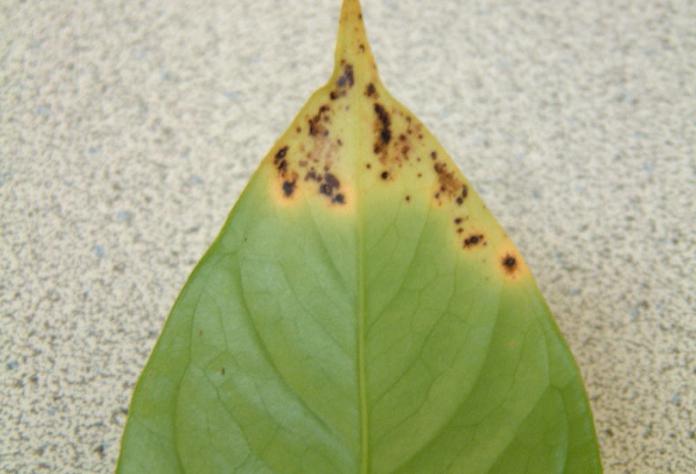

Maintaining comfortable conditions and regular care will allow the tropical anthurium to bloom profusely and delight you with its exotic beauty.
Anthurium Alabama Pink - (Anthurium Alabama Pink)
Anthurium Alabama Pink - (Anthurium Alabama Pink) has a solid pink bedspread and green with a yellow top of the cob. Catalog number - 14.
Anthuriums differ not only in the color of the bedspread and the cob, the height of the bush, the size of the leaves, the number of flowering cobs. One of the main differences is the shape of the bract leaf (veil). The pink anthurium leaf Pink Fever has a narrow, elongated, twisted shape (ribbon shape). A small flower of this anthurium variety is compensated by their abundance on the bush, up to 10 pieces, catalog number 19.
Top dressing
When indoor yucca comes out of hibernation in the spring and begins to grow actively, it needs to be fed twice a month with fertilizer for flowers, decayed leaves or peat. In summer, top dressing is carried out every ten days, and in winter - at twenty: 1 tbsp is added to a bucket of warm water. a spoonful of granular and liquid fertilizer for flowers. They are available in a large assortment in the store. As soon as autumn comes, feeding is not required, since the palm tree stops actively growing and goes into a state of dormancy.
Photo
Further in the photo you can see what the flower looks like:
Description and distinctive features of the anthurium plant
The birthplace of the flower is Central and South America. There the plant is called a flamingo flower and a fiery tongue. Anthurium is also called Male happiness, because it is customary to present it as a gift to men. The inflorescences are heart-shaped. Brightly colored and always eye-catching. Due to this spectacular appearance, the culture is widely used as a houseplant.
The flower is capable of reaching a meter in height. The leaves are large enough, up to 40 centimeters long. Dense, leathery, dark green tone. Sometimes there is a waxy coating. The form is heart-shaped, elongated, broad-lanceolate. The edges are dissected or whole. The leaves look very attractive. But exotic inflorescences are considered the main decoration. They are small, collected in a dense cob of a spiral or cylindrical shape. Around the base of the ear there are brightly colored, large leaves of a red hue. They are called the veil. This unusual combination gives the bush originality.
The color gamut is wide enough. There are examples of blue, burgundy, red. Anthurium pink and white looks beautiful. There are also dark, almost black variants. In our latitudes, bright red flowers are considered the most common. As for the content, caring for white anthurium is similar to caring for plants of any other color.
Anthurium has a specific, slightly tart aroma. Looks great in pots and cut. Florists are highly regarded for the ability to form unusual flower arrangements. But you should be careful, because anthurium juice is very poisonous, so it is recommended to place the pot out of the reach of children and animals.
Many are interested in the question of when does the anthurium bloom in the apartment start and how long. It all depends on proper care. Providing good conditions, the flower will delight with its beauty throughout the year. Anthurium is recognized as the longest flowering plant. The maximum break in flowering is 3 months of winter. Read the article on the azalea flower.
What types of flower are there?
At the moment, about 800 types of anthurium are known. However, not all are suitable for indoor cultivation. Varieties of anthuriums are combined into three large groups: green-leaved, flowering and variegated.
Consider the most popular types of anthurium that can grow at home.
There are many types of anthuriums, for example, Alabama, Orange Love, Andrianum Mix, Utah, Red King, but most often flower growers choose these options:
- Scherzer.
- Turense.
- Black queen.
- Andre.
- Mix.
- Dakota.
Scherzer's Anthurium
The stem is very shortened, its length is up to 40 centimeters. Leaves are leathery, matte, painted in a dark green tone. Black dots are visible on both sides. Peduncle height up to 30 centimeters.The bedspread is red-orange. Scherzer has a rounded ear. As a rule, it is yellow or orange. Simple care for Scherzer's anthurium at home and a beautiful appearance are the reasons for the high popularity of this species. The culture blooms for three months. Inflorescences fade from bottom to top. Anthurium Andre
This is the result of crossing two varieties: Linden and Scherzer. A bush grows up to 1 meter. It is characterized by large leaves, airy type of root system. The peduncle is quite long - about 15 centimeters. The blanket is heart-shaped, reaching 20 centimeters in length. The surface is glossy. Metallic luster is present. If Andre's anthurium care is carried out correctly, the plant will bloom for a very long time.
Anthurium Turenza
Anthurium Turenza is distinguished by a constant bright red color. The leaves are shiny, have a beautiful structure. The flowers look mesmerizing. They look great in any living space and are a status symbol in the office.
Anthurium Black Queen
Anthurium Black Queen is a real delight for its noble color. The bedspreads are painted in black or in a shade of overripe cherry. The variety is unusual. It looks very elegant.
Anthurium Mix
It is a Mix variety, a mixture of varieties of one of the species or several types of plants. Caring for Anthurium Mix at home is quite simple. The main thing is to observe moderation in everything. And also not to violate certain rules of cultivation.
Anthurium Dakota
Anthurium red is grown at home most often. And the Dakota variety is especially popular. This is a very vibrant culture. It is characterized by the presence of a glossy bedspread and a yellow cob, which consists of many small flowers. The plant stands out not only for its rich tone, but also for its rather large size. The size of the bedspread varies from 14 to 23 centimeters. Even in a spacious room, such a spectacular culture cannot be overlooked. Caring for the Dakota anthurium is a pleasure. After all, the variety is not capricious and requires a minimum of attention.
Photo gallery
Care features
Black anthurium requires the same care as any other variety of this crop. If the plant grows and develops poorly, you can see characteristic signs on it that indicate a particular violation. For example, if the leaves of an anthurium turn yellow, most likely it does not have enough light. Watering rules may have been violated. Any changes on the surface of the plant may also indicate a lack of essential nutrients. In this case, fertilization is necessary.
The appearance of light spots on the leaves can provoke hypothermia. Then the plant must be rearranged to a warm place. Brown spots indicate that the crop needs to be watered less frequently. If black spot appears, it is likely that there is an excess of calcium in the soil. In this case, it is necessary to change the land.
Spots on flowers appear due to violations of watering rules. It is recommended to water the plant at the root, and when irrigating, avoid getting water on the peduncles.
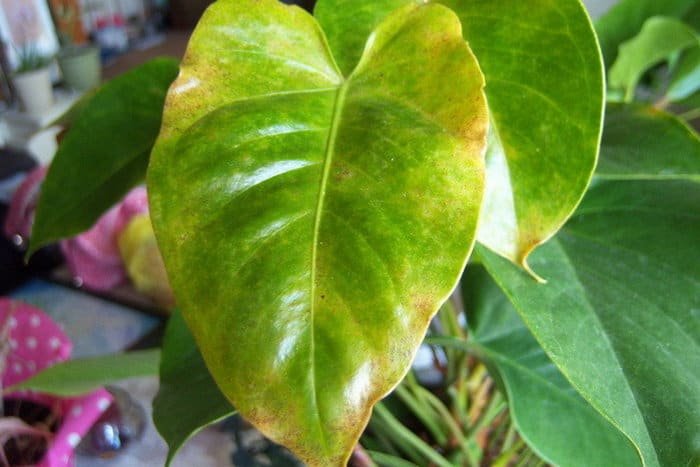

Watering rules
Anthurium is watered once a week. But watering should be abundant. If the plant has bloomed, moistening is carried out up to 3 times a week.
In summer, during heat and dry weather, the plant is sprayed. Avoid getting water on the flowers. The water must be settled. Also during this period or during the heating of the apartment, it is recommended to place a container open with water near the plant.
Temperature indicators
Anthurium loves warmth. Therefore, the optimal temperature for its high-quality growth is +20 - +25 degrees. If the air temperature is below +15 degrees, the plant may stop developing. Lower temperatures lead to the death of the culture.
Lighting
The flower does not like when direct sunlight falls on it.Therefore, it is recommended to choose a shade for the plant. It is strictly forbidden to put anthurium on the windowsill.
Top dressing
The plant is demanding on fertile soil. It is necessary to add peat, wood ash to the soil, you can purchase special soil in stores for these plants.
Flower feeding is carried out twice a month. They use not only organic, but also mineral fertilizers. The first feeding is carried out when young leaves begin to appear en masse on the plant. The second time the plant is fed when buds appear.
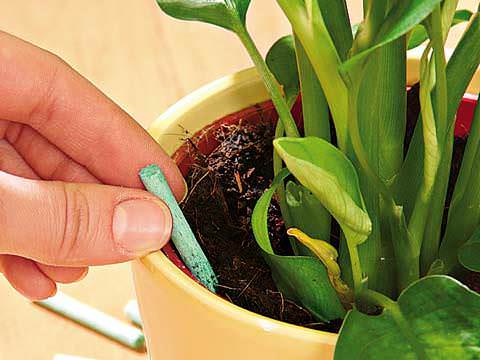

Black dragon
This type can also be very rarely found in indoor collections. The plant differs not only in its decorative effect, but also in its unusual color of foliage. Lanceolate elongated leaves grow on short petioles, while forming a lush herbaceous bush. The color of the leaves is variegated, it changes over time from green to bright burgundy blotches.
The ear color is close to brown tones. The ear shade changes to yellowish brown as the final flowering phase approaches.
Similar flowers
- Calla Black Crusader... The shiny bedspread is somewhat twisted and has a blackish tint.
- Calla Black Forest... The bedspread is a deep purple sail. White edging along the very edge.
- Calla Black Pearl... The bedspread has an open bedspread of a deep purple hue.
- Calla Black Star... The bedspread has the shape of a tulip, the colors are violet-black.
- Calla Maron Sensation it is distinguished by a shiny bedspread of the color of ripe cherries with a blackish tint.
Despite the "royal title", Anthurium Black Prince is quite unpretentious and hardy. With proper care, it grows quickly and multiplies easily at home.
If you find an error, please select a piece of text and press Ctrl + Enter.
How to prune a yucca?
It is best to prune the plant in spring, when it has just been freed from winter shelter. Since the yucca has only one growth point, by cutting off the stem, the gardener completely stops its vertical development. And yet the life of the flower will not freeze, the buds sleeping on the stem will wake up and give several new outlets.
Pruning is a great way to rejuvenate the flower, get strong garden yucca seedlings, and save rot or frost-affected specimens.
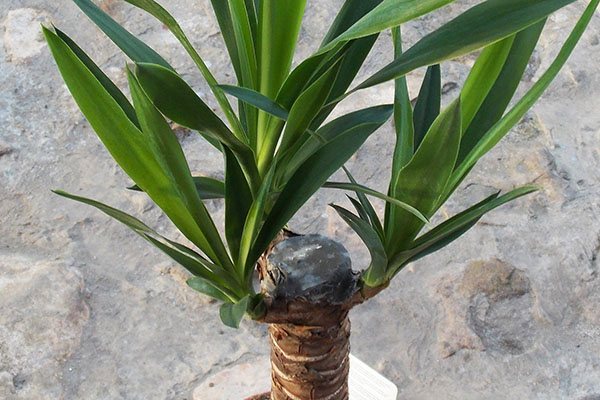

Before cutting the yucca, water the plant a couple of days before the operation. The cut is made with a very sharp, clean knife so that:
- in its place there were no splits of the stem, damage or detachment of the bark;
- it fell 8 - 10 cm below the foliage growth line.
When the places of the cuts dry out a little, they, both on the hemp and on the top, are treated with fungicide and charcoal powder.
The top of the hemp remaining to the ground after pruning the yucca can be covered with garden var, which will provide long-term reliable protection in the garden.
On an old plant, covered from the scorching sun, sprouts will appear newer in 2-3 weeks. If the yucca is strong, 3 to 5 buds are left on the hemp. Small specimens will not be able to support the growth of more than two young tips.
The old top is not thrown away, but used to plant a garden yucca, the care of which differs little in the situation when daughter sockets are transferred to the ground. True, before this, the seedling needs to be rooted. It is best to do this in a greenhouse, keeping an eye out for condensation to form and keeping an eye on the moderate moisture content of the sandy substrate.
Yucca filamentous - video
Extension of roots, planting of anthurium Black Prince
Not so long ago, I shared with you the story of anthurium, "Black Prince". My first anthurium, a favorite of the family, who for a long time delighted us with beauty and abundant flowering, at one time began to wither and made me and my whole family worry.
To save the Prince, I had to decide on pruning the plant.All this time, while the top of the anthurium was in "Vermiculite", to build up roots, I was very worried, because he was sick for a long time.
Watching him closely, I noticed that the leaves remaining after pruning began to dry out, one leaf had to be cut off, now only a stalk remained from the anthurium.
Hurray, after a couple of days a new leaf began to hatch. So, the plant did it, it gave me hope for its revival.
Sphagnum moss gave a quick result, on the growth of roots
But the joy was not long, the second leaf began to dry up, and urgent measures had to be taken. I removed the anthurium from the container, it was not difficult, because "Vermiculite" is loose and the plant is very easy to pull out. The roots were not large, I expected a better result. I was pleased with the young leaf and shoots.
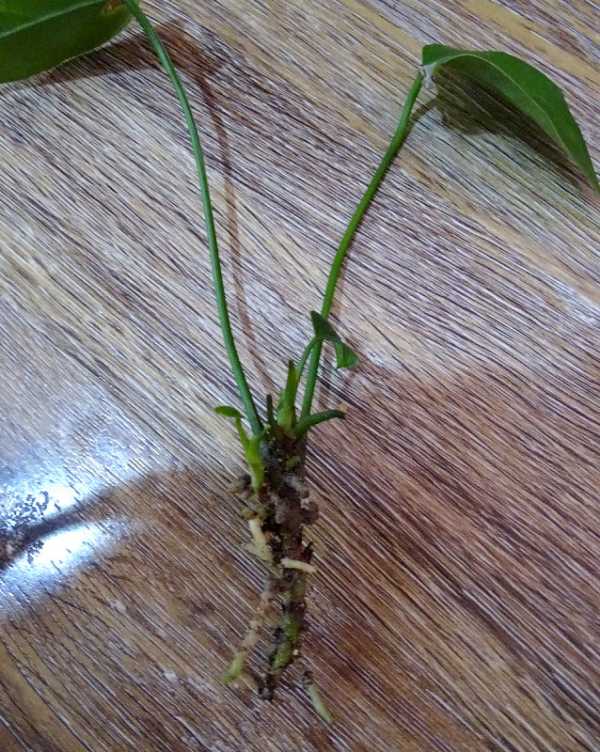

Small roots, young leaves and shoots
Wrap with swamp moss
With such small roots, afraid to plant it in the ground, I decided to grow the root even more. Covered the bottom of the plant
"Sphagnum" (marsh moss) and wrapped with cling film. I put it in a jar, placing it in a bright place. Once every 3 days, I unwound the film for airing and, if necessary, sprayed it with water, the moss should be wet. Soon, young roots became visible through the film, and the sprout and leaf formed in "Vermiculite" grew considerably. Judging by the time, in my case, "Sfagnum" gave a faster result than "Vermiculite".
Planting a small anthurium Black Prince in the ground
After making sure that everything is in order with the anthurium, I decided to transplant it into the ground. For transplantation, I used a ready-made substrate component "Auriki's Gardens", "Aroids".
It includes: sod land, sand, bark and pine needles, sphagnum, vermicompost.
For looseness I added a little "Vermiculite" and "Perlite". Unwound the film, the roots are rich, strong, with such a root system, the plant will quickly take root and grow.
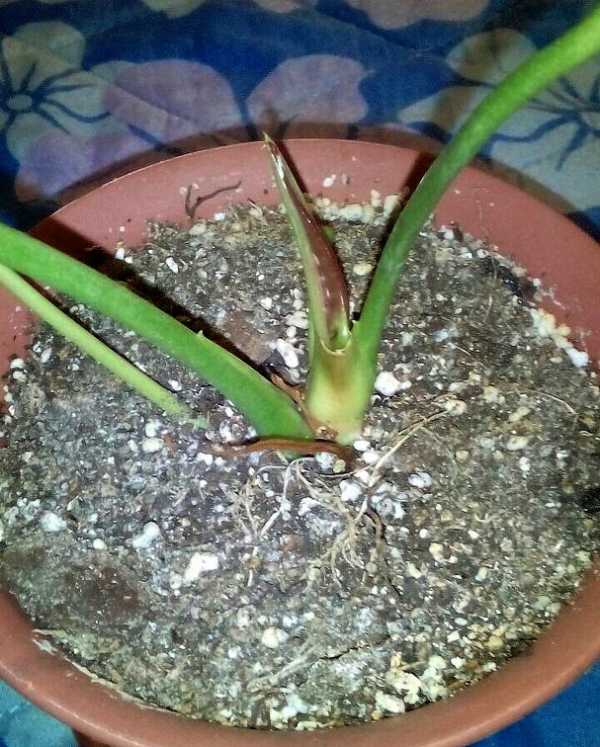

Transplanted Little Black Prince
The second sheet remaining after trimming had to be cut off. It was dried up, wrinkled, fulfilled its function, and now it should not take nutrients from young leaves.
The story turned out to be sad, but instructive and, most importantly, with a happy ending.
- The first part of the story: The unfinished story of the Black Prince
- Second part: Pruning anthurium, you need to give one last chance
- Third part: Welcome back ..., Little Prince (This post)
- The final part: Not a fictional story with a happy ending
Views
There are about 900 species of anthuriums. Indoor varieties can be divided into three main groups:
- Beautifully flowering species. They are used not only in pot culture, but also for cutting. Outstanding representatives are Anthurium Andre, Sierra, Turenze and Scherzer.
- Species with colored patterns on the leaves and a short climbing trunk. Some of the representatives are Anthurium Khrustalny, Varoka and the Majestic.
- Decorative deciduous species. They have long stems and green leaves. Representatives - Anthurium Baker and Climbing.
Each variety has its own characteristics. So, anthurium Amalia has a subtle aroma, Otaz has a fetid odor, which makes this species not so popular.
Shelter for a garden yucca for the winter
Plants tolerate sudden snow falling out in autumn or spring without loss, the main thing is that it melts within a couple of days. But stable cold weather and snowless winters are deadly for garden yucca.
First of all, the growth point in the core of the outlet suffers from frost, and then the vegetative root system. A frame shelter, representing a spacious box as high as an adult plant, helps to protect the culture.
Before covering the foliage, the yucca are collected up and tightly wrapped with a strong cord. Then the plant is covered with a box on top and abundantly sprinkled with spruce branches or fallen leaves. The entire structure is wrapped with a covering material and secured with tape. Checking the stability of the structure.In this form, the plant will spend the winter without problems, it will be especially comfortable under a layer of snow.
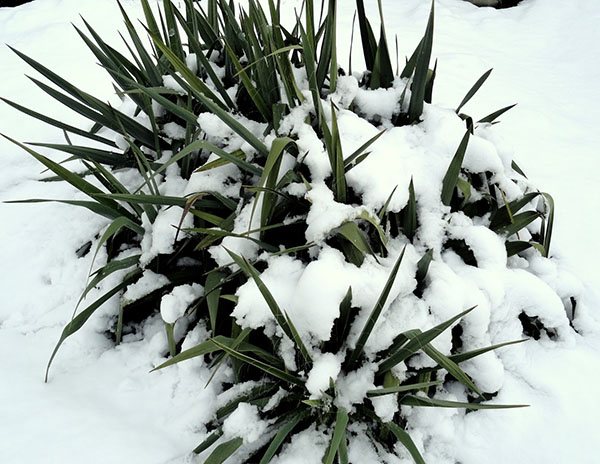

You can remove the frame and remove the foliage with the arrival of stable positive temperatures. If you are late with the "release of the captive" there is a danger of mold and decay due to the activation of respiration and the beginning of the growing season of the plant inside the enclosed space.
Growing problems
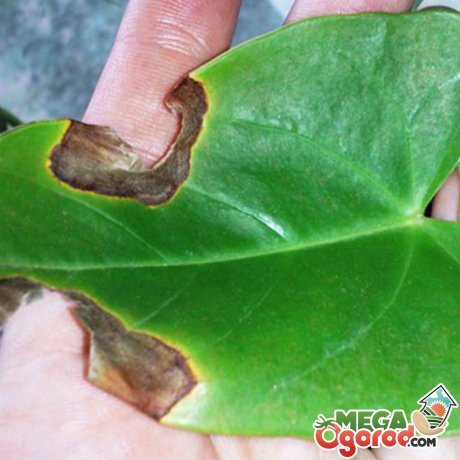

When growing anthurium Black Queen, you need to carefully monitor its condition. Most often, they suffer from the following factors:
- High indoor humidity.
- Incorrect temperature conditions.
- Poorly chosen place for a flower.
- Frequent watering.
Any problems are reflected in the appearance and condition of leaves and flowers:
- Leaves turn yellow with improper watering or insufficient lighting.
- White spots appear on the leaves when the plant is kept at low temperatures. You can get rid of them by moving the plant pot to a warm place.
- If brown spots appear, they also rearrange the pot with the plant in a warm place and reduce the amount of watering and the amount of water applied.
More information can be found in the video:
Anthurium Pruning Black Prince
Pruning, last chance, I made up my mind. Having unwound the coconut flakes, I did not see any growth of aerial roots, it is possible that too little time has passed. She started pruning, retreated 3 cm from the soil and cut mercilessly.
True, she cut off the wrong word, rather sawed off, let me remind you, the plant is adult, the trunk is massive, thick and, moreover, turned out to be dry.
Apparently, it took me a long time to decide, wait, experiment. As a result, I sawed the trunk by centimeters until I reached the living tissue. A segment of about 45 centimeters long remained from the 1.7 meter handsome man, but alive, and this is already hope.
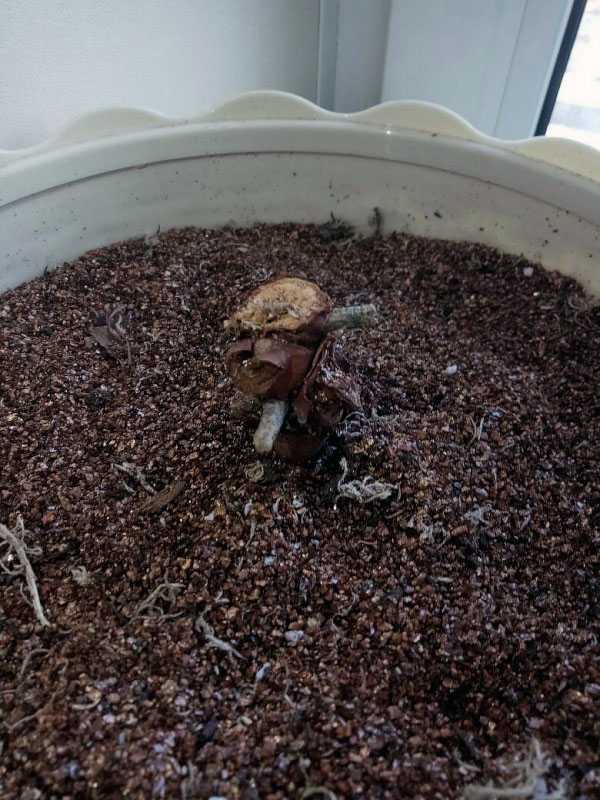

Anthurium is cut off, the top is planted
I put him in "Vermiculite" mixed with "Perlite". For this I took a transparent, plastic bottle. Through it it was convenient to observe the growth of the root system. And the plant that remained in the pot, from the pruning, was put on the window. Before that, part of the aerial roots was covered with the same "Vermiculite" and "Perlite", leaving one aerial root on the surface. I decided on it, I will monitor the state of the root system. Hoping that growth will come from the root.
It's been two months now, the aerial root is alive
The pot with the root did not sprout, but the aerial root remaining on the trunk was alive.
And the cut off top pleases, through a transparent bottle, the roots became visible, and a leaf appeared, although very, very small.
I decided not to wait a lot, not to transplant, let the roots strengthen, the leaf grows. I'm afraid to hurry, so as not to harm. I really want everything to work out, and the Prince delighted him with his beauty and grandeur for a long time. Although my very first baby from the Black Prince is growing up, there is a photo on the page "My collection".
There is an opinion that children from domestic Anthuriums do not grow to the size of their parents.
This is not true, my example is my case, the size of the Prince's flower was 17.5 centimeters, and the child's 17 centimeters, the size of the leaves in adult plants is the same.
Agree that 0.5 centimeters is not an indicator. Therefore, when purchasing a baby from a home Anthurium, drop all doubts.
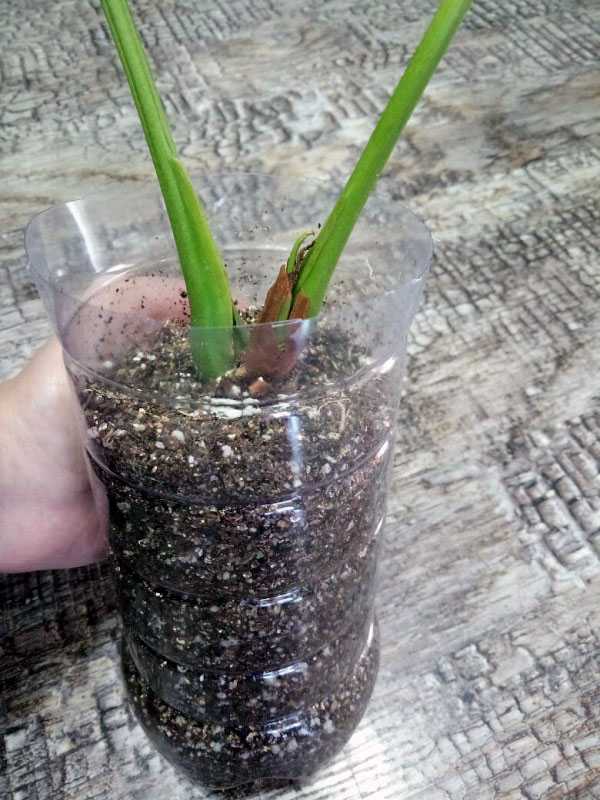

Top from the Prince
The story is instructive, I drew conclusions for myself. I realized my mistakes made when leaving, which I will try not to repeat again.
My first mistake was that I did not reduce by watering in the autumn-winter period, which led to decay of the root system. The second mistake, a lot of time was spent thinking. I would have acted more decisively, I would not have had to cut the plant so much, and yet a little more and I would not have been able to save it.
Experience in anthurium rejuvenation
On the positive side, this is an experience in rejuvenation, hopefully successful, time will tell.
Again, I failed to rejuvenate with coconut flakes and aerial roots.
In this way, my daughter is trying to rejuvenate her Anthurium, if the experiment succeeds, I will definitely tell you about it. And I will also keep you informed of all the events taking place with my Prince. If you want to make comments, share your experience, tell your story, write in the comments, we will definitely discuss. I would be glad to talk about this topic. After all, good advice will not be superfluous to anyone, neither me nor you.
- The first part of the story: The unfinished story of the Black Prince
- Second part: Pruning anthurium, you need to give one last chance (This post)
- The third part: Welcome back ..., The Little Prince
- The final part: Not a fictional story with a happy ending
The most common mistakes in farming
Inexperienced florists, who ventured to acquire an anthurium for the first time, make standard mistakes in agricultural technology due to excessive enthusiasm.
The most common reason for the death of a tropical dwarf shrub is:
- Waterlogging or drying out of the substrate;
- Insufficient aeration of the soil mixture;
- Keeping in bright light in direct sunlight;
- Destructive drafts, causing hypothermia and loss of moisture;
- An attempt at rooting cuttings in water;
- Hypothermia of the plant in winter;
- Sharp fluctuations in the average daily temperature.
Anthurium is mistakenly considered a capricious houseplant. In fact, the main reason for the death of valuable specimens is an elementary misunderstanding of the vegetation of epiphytic species.
Anthurium is a plant of the Aroid family, which numbers more than 900 species in the wild. The homeland of anthurium is the tropical forests of South America, in Russia it is an indoor or greenhouse plant with beautiful flowers and a dense ear, because of which anthurium is commonly called a male flower, or male happiness. Black Queen Anthurium is a hybrid variety with a light green ear and a black petal veil.
How to propagate yucca?
Although with proper care after planting, the garden yucca, as in the photo, blooms, it will not work to wait for its seeds in the middle lane. How to propagate garden yucca? There are several ways to get young independent plants. Most often, daughter rosettes are used, which are formed at the base of an adult bush. It is better to take layers with an already developed own root system. This will speed up acclimatization and allow plants to quickly develop in a new location.
Daughter outlets are easily detached when transplanting garden yucca, while caring for them is no different from what other plants receive. At the same time, do not forget that the cut sites are most susceptible to all kinds of infections and pest attacks. Therefore, they are slightly dried and sprinkled with crushed coal or cinnamon powder.
During a spring transplant, several cuttings from 5 to 10 cm long can be cut from a healthy strong root. They are treated with coal and planted in a greenhouse, lightly sprinkled with a wet sand-peat mixture. In this case, the formation of sprouts occurs due to dormant buds.
Another way that allows not only to rejuvenate a plant that has grown and lost its compactness, but also to propagate an exotic guest, is pruning. How to make yucca more fluffy and get quality planting material?
General information
Anthurium is a pretty beautiful flower with original flowers and decorative leaves. Anthuriums growing at home can be divided into three groups: variegated or deciduous ornamental, flowering and green-leaved. Anthurium Black Queen belongs to the green-leaved group.
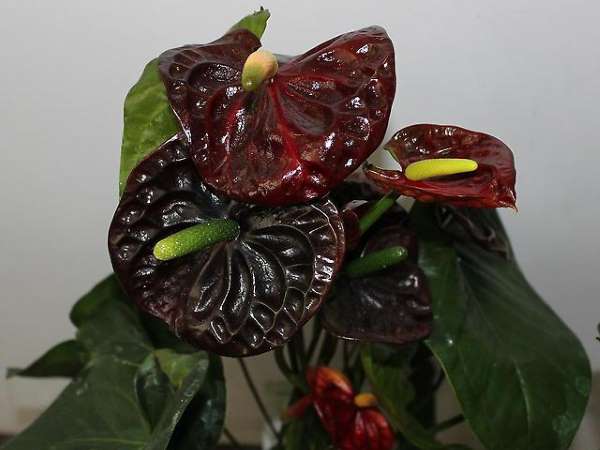

In deciduous-decorative anthurium, not only flowers are beautiful, but also leaves, as, for example, in crystal anthurium. Its leaves are unusual because of the light veins that form an original pattern on a dark green background.
As for the Black Queen variety, it differs from other relatives in that its bract or veil is black with a red tint. At the beginning of flowering, the buds have a cherry blossom, but over time, the bracts turn black, retaining a red tint, the leaves of black anthurium remain green throughout their life.
Black Queen is a hybrid variety that has retained all the features of the parent varieties, so not all flowers on the bush can be black, some remain red. As a result of such a variety, the flower has a rather original look - black-red and red flowers with light green cobs look beautiful together with green leaves.
The black prince, or black queen, is a flower for lovers, not all growers are impressed by its mournful look, but some growers like to have such an unusual specimen in their collection.
Another hybrid variety of anthurium with dark flowers is anthurium Chocolate Love. Anthurium varieties chokolat lava - it is distinguished by a brown bracts, a light cob and green leaves, it belongs to the group of green-leaved anthuriums.
Temperature and humidity
The optimum air temperature for anthurium depends on the vegetative phase. During the period of active growth and flowering, the air temperature in the room should be within + 20 + 25 ° C. An evergreen shrub enters a dormant phase after a long flowering, often lasting 10-12 weeks.
In the resting phase, the air temperature in the room with anthurium should not drop below + 15 + 18 ° C. In a cooler room, the plant will die.
Epiphyte requires high air humidity and reacts positively to year-round daily spraying with soft boiled water in the morning.
Conclusions about the anthurium flower
Thus, anthurium is a fairly popular houseplant. Its unusual appearance, variety of varieties and colors - these are the advantages for which it is so highly valued by professional growers and amateurs. The culture is rather unpretentious in its content, it takes a minimum of time. Therefore, caring for her is simple. But it is important to follow a number of rules and provide the anthurium with suitable growing conditions. Otherwise, the flower will start to ache, and will not delight with its beauty for a long time. See the article: Why does geranium not bloom at home and in the garden?
How to plant a yucca?
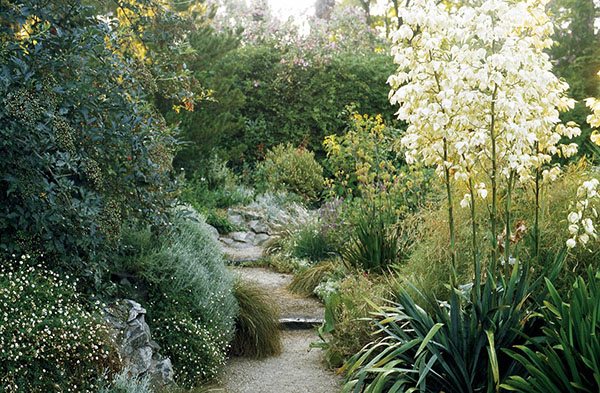

Yucca is unpretentious and hardy. She is not afraid of drought, heat and wind, but the main enemy of the plant is waterlogging and heavy soils, where there is a risk of moisture stagnation.
To simplify the care of the garden yucca, in the photo, planting is carried out in a well-ventilated, sunny place. When choosing a site for an exotic beauty, you should avoid the lowlands and corners of the garden with dense shade. The long stay of partial shade leaves a mark on the external appearance of the culture. The leaves lose their former density, the trunk is pulled out. As a result, the plant looks rather sloppy even when given full care.
Yucca has no special requirements for the composition of the soil. The main thing is that the roots receive enough air, and the water does not linger in the soil. Therefore, before planting yucca, sand is added to the substrate for filling the pit in areas with dense black soil or clay. A drainage layer is needed at the bottom, and humus is added to the substrate to provide nutrition, especially on poor soils.
Despite the unpretentiousness of the culture, it will not work at all without leaving after planting yucca in the open field.

